#1966 had 6 issues
Explore tagged Tumblr posts
Text
Random Teen Titans thoughts, 1966 edition:
-nothing can escape Aqualad’s notice. Not giant, noticeable ears or giant, metal conquistadores
-I’m pretty sure TT #1 is the introduction to characters, especially Robin, saying “Quick like a bunny, Kid Flash!” which is just really funny to me
-this happens more often than I thought (I’m rereading these early comics), but Robin almost always explains things when asked. And his explanations are always long and in-depth and he is a giant nerd
-Robin says “What can possibly happen?” because he’s Robin and that’s just what Robin does
-Robin says “Hope there’s nothing more popping from that pyramid!” because he did not learn his lesson the first time
-the villain made a giant, metal conquistadore, but the weird animals with human faces were just incarnations of the beast god. Nobody questions this
-I think Kid Flash practices by juggling with his feet. Otherwise, I have no idea what the panel was implying
-“You’re strictly feom Squaresville if you don’t put down the drags - like you’re cubed, but def!”
“You sure that is English, Penny?”
I love this interaction and I’m with Garn on this one, sorry, Penny
-Aqualad says “great waves and all that jazz” basically mocking the interjections they’ve all been saying (including him) and I just think that’s funny
-Kid Flash says “Better find a hole in the sky, and hide this egg-beater, Robin!” and no, context does not make it make any sense
-Wonder Girl ties her hair to a tree branch because her grip is slipping. Miraculously, this works
-the image of Wonder Girl holding up Aqualad, who is holding up Robin, who does not seem to notice nor care about his current predicament, is both adorable because Robin has such complete faith in his teammates and hilarious because he is dangling precariously with only an Aqualad to keep him from falling
-Aqualad says “Quick like a bunnyfish- if there is such a thing!” I’m pretty sure he’s making fun of Robin
-Gotham banks have machine guns set up in their walls, in case of burglaries. This explains quite a lot
-Robin says his math mark (his math grade) could be better, and I do not believe him
-Ding-Dong Daddy Dowd’s shop is called Ding-Dong Daddy Dowd’s Hot-Rod Hive: the Hottest Buckets This Side of Dragsville, and I don’t know how to feel about that
-Robin gets handcuffed to a speeding motorbike. He can’t stop the bike, but I just don’t understand the thought process. If Ding-Dong wants him dead, why did he not just kill him? Ding-Dong is a ding dong
-Kid Flash: “I failed.”
Aqualad: “I failed.”
Robin: “We all failed.”
10/10 leadership
-The narration claims that there was an outstanding outcry for Speedy to be added. I don’t know if I believe them. This is only issue #4
-Speedy decides it would be better to break into the Teen Titans’ hideout and set off the alarm, instead of giving them any head’s up that he’s coming. He’s right, it was better
-someone swapped Speedy’s arrows with explosive-rigged arrows and expected Speedy not to notice
-Davey (important character)’s dad tries to intimidate Robin, which was just hilarious. You really think Robin, Boy Wonder from Gotham City (the city with machine guns in the bank walls) is going to be intimidated but a bad dad? Silly
-Kid Flash says “I’d know that beautiful racing form anywhere!” of Davey, and I just think that’s funny
-Davey’s dad is the absolute worst. He made his son cry. He’s such a dick
-Davey says “I’m going like a big-tailed bird, Robin!” and I just don’t understand the relevance
-Davey’s dad decides to be less of an asshole, which is nice
-this exchange between Wonder Girl and Robin:
“He’s cute- cuter than any of you characters!”
“You can bet your magic lasso, W.G., that we will hook up with Speedy again!”
-the Ant is the son of a circus strongman and an acrobat. He and Robin should be pals
-Robin calls Aqualad “Sea Flea”
-Beast Boy can’t be part of the Doom Patrol without guardian permission. He also can’t be part of the Teen Titans without guardian permission (Robin saying “Batman had to okay me!” is funny because who did Batman okay Robin to?) Beast Boy thinks they just think he’s a freak, and runs off to the circus
-I saw a review say that Beast Boy’s arc was too similar to Pinocchio, because Beast Boy wants to “be a real hero,” but I have no idea where that idea came from? Beast Boy doesn’t give a shit about being a hero, he just wants to go somewhere and feel like he belongs
-Aqualad says this: “Holy hagfish, Robin… you figure we can get away with this bit- impersonating circus performers?” which is just funny because he’s asking the circus performer if he can accurately perform in a circus (I don’t think the Teen Titans know each other’s identities at this point)
-Robin calls Aqualad “Minnow”
-Robin says they should rethink letting Beast Boy join the team, and in the end, it’s left up the the audience to decide. As in, us, the readers reading the comic. As I said before, I’ve read a lot of these comics before (up to #43), and Beast Boy does not appear as part of the team in any of these issues. Poor Beast Boy
-I ship Robin and Aqualad, and I can’t explain it. I just find their dynamic, Aqualad questioning Robin and Robin being generally unfazed, is cute. And he calls Aqualad “Minnow” come on
#the inane ramblings of a madman#teen titans#60s teen titans#robin#wonder girl#kid flash#aqualad#speedy#dc comics#dc#1966 had 6 issues#which is just kinda neat#long post#i really like robin and aqualad#they are very funny#aqualad is absolutey vicious#‘you led us in here to get us away from a trap and now we’re trapped’#thanks aqualad#nobody doubts yet trusts robin as much as aqualad#look the ship makes perfect sense if you’d just look at my corkboard-
18 notes
·
View notes
Text
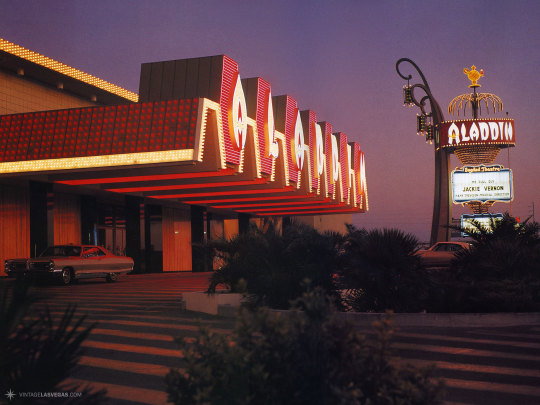
Tally Ho / Aladdin / Planet Hollywood
Aladdin opened in 1966 with one of the Strip's first neon-enhanced porte-cochéres, a freestanding sign featuring a revolving, three-sided marquee, topped with an "Aladdin's Lamp," designed and fabricated by YESCO.
Tally Ho ('62-'65)
'61: Edwin S. Lowe announces plans for Tally Ho non-gaming hotel. In the 40s the land was owned by locals Salton, Rose, and Goldberg. (Alexander & Rebecca Salton, founding members of the Las Vegas Jewish community.)
'62: Dec. 24, Opening of Tally-Ho, hotel and country club with 9-hole golf course. 322 of the 450 rooms open during “preview opening” in Dec. The hotel was alternately spelled Tally Ho, Tally-Ho, and Tallyho.
'63: Oct. 11, Tally Ho closed. “Ed Lowe made no excuses … admits he was dead wrong about a no gambling luxury hotel.” (Hertz, RJ 10/13/63)
'63: Oct., Norman Kaye and Frank Windsor operate the Tally Ho golf course.
'63: Oct.-Dec., The hotel is sold to Kings Crown Inns of America, represented by Floyd and Beryl Cook, Donald Bolinger (Cooks Brothers Trusts, Indiana). Under lease to operators Edward Nealis, Charles Luftig, and partners, Kings Crown Tally Ho's hotel, lounge, and restaurants reopen in Dec. (Duke, RJ 12/20/63)
'64: Construction of a showroom and casino begins in Fall, misses New Year's Eve opening deadline. The showroom and casino are completed in '65, ultimately never opened. (RJ 4/8/64, RJ 5/18/65)
'65: Nealis heads 18 casino applicants of Tallyho Operating Co. who are unable to get approval from Nevada Gaming Control Board (GCB). In later years Jimmy "the Weasel" Fratianno of the Los Angeles crime family claimed he owned a piece of the Tally Ho and was to run the casino. (AP, 2/17/65, RJ 11/25/84)
'65: Apr. 1, Tally Ho closed for the second time after King's Crown files suit against Tallyho Operating Co. for unpaid rent. Tenants are evicted, property put in control of the owners.
'65: Dec., Tally Ho bought by Milton Prell (Prell Hotel Corp.) from The Cooks Brothers Trusts.
Aladdin ('66-'97)
'66: Aladdin announced. Drawings for redesigned casino and proposed hotel tower unveiled early in the year. Martin Stern, architect. (RJ 1/2/66, RJ 1/17/66)
'66: Mar. 31, Aladdin opened. Freestanding sign and the Strip's first neon-enhanced porte-cochère by YESCO. Primary owners M. Prell, G. Gilbert, and S. Krystal, all former members of Sahara-Nevada Corp. Comedian Jackie Mason opens the 500-seat Baghdad Theatre.
'66: Dec., Prell stops $75k/month payments on the Aladdin and asks that the price be cut. The trustees agree to reduce the sale price to $5.5M. (Dayton, 4/20/72)
'67: Sep. 26, Milton Prell suffers a debilitating stroke which removes him from Aladdin management. (Dayton, 4/20/72)
'68: Apr., Stockholders of Prell Hotel Corp. vote to merge with Parvin-Dohrmann Co., leading to Parvin-Dohrmann take-over the Aladdin.
'68: Jun., Parvin-Dohrmann operation of Aladdin’s casino approved by GCB. (RJ 6/20/68)
'68: Sep., 28, "after the stock trade was finalized, Milton Prell, by this time paralyzed, was told by the new management he had two weeks to get out of the Aladdin." (McKnight, Alexander. Journal Herald, 4/20/72)
'70: Parvin-Dohrmann adopts the new name Recrion, and strips the firm of all its holdings except for its three Las Vegas hotel-casinos: Aladdin, Fremont, and Stardust.
'71: Oct.-Dec., Recrion announces sale to Sam Diamond, P. Webbe, R. Daly, D. Aikin as Aladdin Hotel Corp. Diamond announces plans for hotel tower.
'71: Entertainment director James Tamer is involved in secretly managing the casino and directing the skim, according to later conviction.
'74: Aladdin investigated by GCB for issuing comps to organized crime figures.
'74: Groundbreaking for the “Tower of Majesty” high-rise, and theater. Lee Linton, architect. Years later in '83, Linton and Aladdin attorney Sorkis Webbe are each convicted of tax fraud in relating to a kickback scheme during the '74 expansion.
'76: Jul., Tower and Theatre for the Performing Arts opened; new porte-cochère by Charles Barnard, Ad-Art; original sign replaced; all financed by Teamsters Central States Pension Fund loan.
'76: Mae Ellen George buys 24% of the hotel, relying on advice of Tamer.
'78: Aug. 3, Detroit federal grand jury indicts Tamer, Aladdin GM James Abraham, Aladdin casino manager Edward Monazym, and Charles Goldfarb (denied a license in ’71) of conspiring to allow hidden owners to exert control over the resort. Owners of the Aladdin at this time are Webbe (34%), Diamond (23%), Mae George (19%), Daly (14%), John Jenkins (8%), and George Morse (2%). (RJ 8/3/78)
'79: Mar. 13, Tamer, Abraham, Monazym, and Goldfarb convicted.
'79: Aug., GCB closes the resort; U.S. District Judge Claiborne opens it hours later, “until a mob-free buyer could be found.” (German, RJ 9/20/2021.)
'80: Jan., Ed Nigro gains a court-sanctioned takeover of the Aladdin after he and Johnny Carson sign an agreement to buy the property for $105M. The deal falls through.
'80: Jul. 10, GCB revokes Aladdin's license and the casino is closed; hotel remains open.
'80: Oct. 1, Casino is reopened after Ed Torres and Wayne Newton buy the Aladdin for $85M.
'82: Jul, Torres buys Newton's shares of the Aladdin.
'84: Feb., Aladdin placed under bankruptcy protection after a Teamsters Pension Fund forces foreclosure.
'85: Jan. 22, Ginji Yasuda buys the Aladdin for $54M; casino closed during Yasuda licensing.
'87: Apr. 1, gaming reopens.
'89: Aug., Yasuda, failing to reveal the source of millions in loans, loses his gaming license; Aladdin forced into bankruptcy.
'90: Aladdin spends the year in bankruptcy, operated by William Dougall.
'91: Jun., Property title transferred to Bell Atlantic Tricon Leasing Corp when no buyers meet the minimum bid.
'92: Jun., Aladdin emerges from 3-year bankruptcy, control is given to Joe Burt and his JMJ management team on a 12-year lease with Bell Atlantic Tricon.
'94: Dec., Jack Sommer, Signman Sommer Family Trust, buys the Aladdin for $80M. "When the family trust sold a major New York property in '94, Sommer needed to find a real estate investment for the proceeds to avoid substantial capital-gains taxes. The Aladdin was on the market at the time." (Simpson. RJ 8/13/2000.) Other potential buyers included Donald Trump.
'97, Nov 25: Aladdin closed. A new hotel-casino to be built on the 35-acre parcel.
'98, Apr 28: Aladdin tower demolished. Former Tally Ho rooms later demolished; Theater remains.
Aladdin (2000-2007) Planet Hollywood (2007-)
2000: New build of the Aladdin. Mall opens 8/17/00, hotel and casino delayed, opening 8/18/00. Cost: $1.1B.
2001: Sep., Aladdin files for bankruptcy.
2003: Aladdin sold for $635M to OpBiz investment group led by Planet Hollywood CEO Robert Earl. Sale finalized 9/1/2004.
2007: Apr. 17, renamed Planet Hollywood.
2009: Harrah’s Ent. purchases part of the $860M mortgage, takes full ownership in Feb. 2010. Harrah’s later rebranded as Caesars Entertainment.
Photos of Tally Ho | Photos of the Aladdin
Headline photo: Undated, circa '68, from The Magic Sign by Charles Barnard.

Circa Feb.-Mar. 1966: The hotel was open before the casino. Installation of the sign is beginning. Photo: Las Vegas News Bureau.




Mar. 1966: Sequence of photographs showing YESCO’s revolving, three-sided Aladdin pylon structure being pieced together by dual cranes ahead of their opening on the 31st. Ad-Art collection, from Charles Barnard’s The Magic Sign.

Undated, Las Vegas News Bureau.
Timeline sources. Previous landowners: C.D. Baker Map of Las Vegas Valley ’40; Alexander Salton. UNLV Special Collections & Archives.
Tally Ho: Tallyho Preview Attracts 3500. Review-Journal, 12/28/62; Tallyho Hotel Closes. Review-Journal, 10/11/63 p1; Murray Hertz. Future of Tallyho Raises Questions. Review-Journal, 10/13/63; Gordon Kent. Tally-Ho Hotel Sold. Review-Journal, 11/1/63; Forrest Duke. New Tallyho Sale Deal. Review-Journal, 12/20/63; Tallyho Plans $1 Million Show. Review-Journal, 4/8/64; Associated Press. Gaming Board Refuses Tallyho Casino License. Review-Journal, 2/17/65 p1; G. Kent, F. Duke. Strip Hotel Closes. Review-Journal, 4/1/65 p1; Tallyho Sues Owners. Review-Journal, 5/18/65 p1.
Tally Ho and Aladdin sales covered in a series by Keith McKnight and Andrew Alexander for The Journal Herald, Dayton OH. Welsh confirmed with crime figures. Journal Herald, 4/20/72; Firm with crime ties linked to casino deal. Journal Herald, 4/21/72.
Aladdin: Associated Press. Gamers Approve. Review-Journal, 6/20/68 p1; Associated Press. Firm adopts new name: Recrion Corp. Reno Gazette Journal, 12/14/70; Lou Miller. Aladdin Hotel sold. Review-Journal, 11/8/71; Jerry Ralya. New Aladdin Corporation seeks license. Review-Journal, 12/29/71; Aladdin execs indicted. Review-Journal, 8/3/78; AP. Las Vegas architect sentenced to prison. Review-Journal, 3/8/83; AP. Webbe convicted. Review-Journal, 6/19/83; Jane Ann Morrison. LV Casinos Targeted in Money Laundering. Review-Journal, 11/25/84; Aladdin Hotel's history spans 30 years. Review-Journal, 1/5/94 p3; Dave Palermo. Aladdin Hotel finally sells. Review-Journal, 12/9/94 p1; History. Review-Journal, 11/23/97 p14; Jeff Simpson. Aladdin owner faces music. Review-Journal, 8/13/2000; Chronology of the Aladdin hotel-casino. Las Vegas Sun, 8/18/2000. John L. Smith. Sharks in the Desert. Barricade Books, 2005; Jeff German. The Genie in the Lamp, and Close the Place Down. Review-Journal, 9/20/2021.
84 notes
·
View notes
Text

Blackbird pilot tells why the SR-71 could fly at Mach 3.55 so long as 427C weren’t exceeded
The Blackbird
The SR-71, unofficially known as the “Blackbird,” was a long-range, Mach 3+, strategic reconnaissance aircraft developed from the Lockheed A-12 and YF-12A aircraft.
T-shirts Habubrats 2
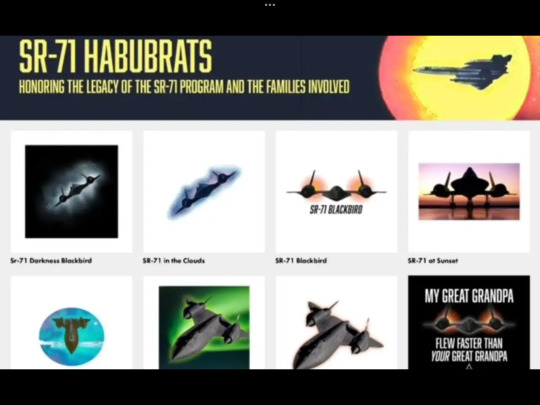
CLICK HERE to see The Aviation Geek Club contributor Linda Sheffield’s T-shirt designs! Linda has a personal relationship with the SR-71 because her father Butch Sheffield flew the Blackbird from test flight in 1965 until 1973. Butch’s Granddaughter’s Lisa Burroughs and Susan Miller are graphic designers. They designed most of the merchandise that is for sale on Threadless. A percentage of the profits go to Flight Test Museum at Edwards Air Force Base. This nonprofit charity is personal to the Sheffield family because they are raising money to house SR-71, #955. This was the first Blackbird that Butch Sheffield flew on Oct. 4, 1965.
The first flight of an SR-71 took place on Dec. 22, 1964, and the first SR-71 to enter service was delivered to the 4200th (later 9th) Strategic Reconnaissance Wing at Beale Air Force Base, Calif., in January 1966.
The Blackbird was in a different category from anything that had come before. “Everything had to be invented. Everything,” Skunk Works legendary aircraft designer Kelly Johnson recalled in an interesting article appeared on Lockheed Martin website.
The SR-71 could fly at Mach 3.55
Today there are many rumors about just how fast the SR-71 could go. The J58 engine temperature limited the top speed. The speed limit for the airplane ironically had nothing to do with the airframe; it had to do with the engines. Right in front of the engine compressor was a temperature probe that reported the temperature to the pilot; when the temperature was around 427C, 800 degrees Fahrenheit, that’s as fast as they were allowed to go.
However, a cold blast from frigid weather could make a difference in reducing the temperature. This would enable the airframe to go faster without harming the engines.
David Peters, former SR-71 Blackbird pilot, explained to me;
Blackbird pilot tells why the SR-71 could fly at Mach 3.55 so long as 427C weren’t exceeded

This print is available in multiple sizes from AircraftProfilePrints.com – CLICK HERE TO GET YOURS. Dawn at 80.000ft – SR-71 Blackbird
‘A little clarification on the speed thing. You are absolutely correct on the 427C. The issue is that I have been limited to less than Mach 3 on a few occasions because the outside air temperature was quite above standard and 427C came up at about 2.95. On other occasions like the Murmansk deal I got above 3.4 (3.49 on the one occasion) and wasn’t close to 427C. The actual limiting airspeed is around 3.55 that is where the spike being at full retraction loses the intercept on the shock wave and can no longer position it correctly in the inlet. ‘Also the overflow of the shock starts to go over the wing and interfere with the flight controls. So the limiting speed as configured would be about 3.55 so long as you don’t exceed 427C.’
Mike Relja, who worked on in with the SR-71‘s for over 30 years, added;
‘I don’t know of any warranty that P&W had or any other parts manufacturer for that matter.
Don’t exceed 427C
‘On the March 6th [Mar. 6, 1990] speed run Ed Yeilding stated that Don Emmons gave them permission to fly the max limit of 3.3 M, they asked Lockheed if they could exceed that number and Lockheed said no if the aircraft had an unstart above 3.3 it may go out of control and come apart hard to keep the pointy end forward. Also, no fuel flow limits established above 3.3 M were ever tested.
‘P&W did give them clearance to exceed 427 CIT for 30 minutes to a limit of 450 CIT but that wasn’t needed they stayed at the book limit of 427 CIT.’*
The engines maker Pratt & Whitney would not warrant or guarantee anything beyond 427; after that, all bets are off the engine could come unglued or you could shed turbine blades. The SR-71 crewmembers were too responsible to risk and exceeded the temperature limit. They wanted to keep the warranty on the engines, the J58’s.
*SR-71 pilot Ed Yeilding (who along with JT Vida as RSO flew the Blackbird during the speed run of Mar. 6, 1990) told me that another reason they didn’t exceed 3.2 is that they were afraid they’d run out of gas before they got to Dullas airport.
Be sure to check out Linda Sheffield Miller (Col Richard (Butch) Sheffield’s daughter, Col. Sheffield was an SR-71 Reconnaissance Systems Officer) Twitter X Page Habubrats SR-71, Instagram Page SR71Habubrats and Facebook Page Born into the Wilde Blue Yonder Habubrats for awesome Blackbird’s photos and stories.
Blackbird pilot tells why the SR-71 could fly at Mach 3.55 so long as 427C weren’t exceeded
@Habubrats71 via X
#sr71#sr 71#sr 71 blackbird#aircraft#usaf#lockheed aviation#mach3+#habu#aviation#reconnaissance#cold war aircraft#aviation military#aviation military pics#military aircraft#military aviation
40 notes
·
View notes
Note
Hi! I’m doing a dick grayson read and have hit a bit of a block on what I should read next. I was wondering if you had suggestions?
So far I’ve read New Teen Titans Vol 1, tales of the teen titans, New Teen Titans Vol 2, and am working my way through the New Titans.
Would you recommend reading a few Team Titans issues? Going right to Nightwing (1996)? reading The Titans (1999)?
-a very lost person
damn that sign off just gave me intense teen vogue flashbacks 🤣 I gotta respond the same way
Dear very lost person,
Hi!! You've covered a lot of the teen titans comics which is actually pretty impressive because people tend to skip but they're really important. If you're focused specifically on Nightwing, I would recommend reading Team Titans Issues #1 - 6 and then Issue #10. I'm very biased towards Nightwing (1996) so I would highly recommend that next but that's not the only reason. Although Nightwing (1996) is a masterpiece and probably my all time favorite reading, I'd go into first before the others because the Titans (1999) is a read as sort of subsidiary to Nightwing (1996). In the Titans (1999) comics, Dick has already established himself in Bludhaven and the reason why he's on the Titans team now is because Wally's like "Dude. You need a break. You need your friends asap." That comic is more of Dick's secondary role because it prioritizes Dick's work in Nightwing 1996) and the Nightwing comic is a standalone.
so order:
Team Titans
Nightwing (1996)
Titans (1999)
JLA/Titans
Outsiders (2003)
Titans (2003)
Teen Titans and Outsiders
Titans (2008)
Nightwing (2016)
Titans (2016)
Titans United, Titans: Titans Together, Titans Bloodpact, Teen Titans: Year One, Teen Titans Lost Annual, Titans Academy, Future State: Teen Titans, and etc are all standalones so it doesn't matter when you read them.
Although if you haven't read Teen Titans (1966) I would HIGHLY recommend reading that first. This is the stories of the OG Titans and I recommend reading that because these stories are referenced in other titans comics such as Titans (1999) and Teen Titans Lost Annual as plotlines.
-A very excited cl
55 notes
·
View notes
Text
Here’s something I’ve been translating on and off for the past week or so! I was looking at old German youth magazines in order to find interesting articles about classic rock bands (specifically Pink Floyd) and came across this in the 01/1978 issue of BRAVO magazine (One of the most famous teen/young adult magazines in Germany that’s been there since 1958 and is still going strong today!) A lot of youth magazines back in the day had articles and posters about rock bands because, well, that’s the people who were celebrities at that time! This page includes both short descriptions of the band members and a short history of the band up until that point when the issue came out! Enjoy ;)
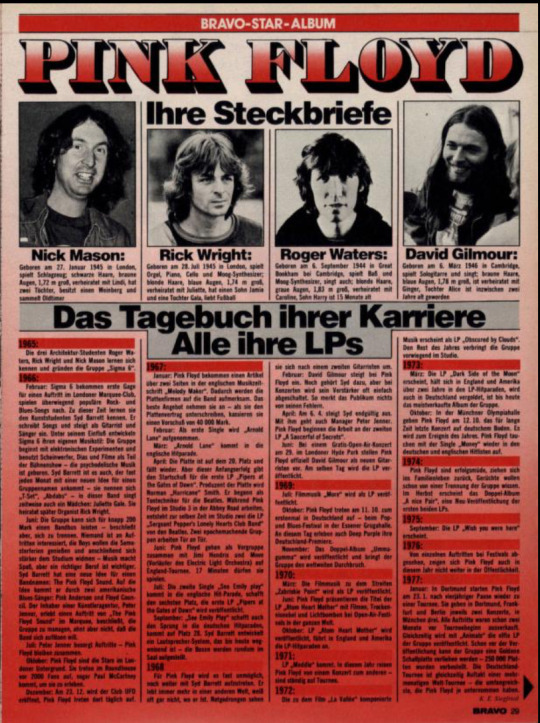
Here’s the original picture
And here is the translation! (Italized text are context comments added by me to add to the understanding of this text!)
Warning: Some of the information here is obviously incorrect!
Pink Floyd: Their profiles
Nick Mason:
Born on the 27th of January 1945 in London, plays drums, has black hair, brown eyes, is 1,72 m tall (for non metric peeps it’s approximately 5 foot 8), is married to Lindy, has two daughters, owns a vineyard and collects old cars (old timers in German means old/vintage cars)
Rick Wright:
Born on the 28th of July 1945 in London, plays the organ/keyboard, piano, cello, and Moog-synthesizer; has blonde hair, blue eyes, is 1, 74 m tall (approximately 5 foot 9), is married to Juliette, has a son named Jamie, and a daughter named Gaia, loves football (or soccer for American peeps)
Roger Waters:
Born on the 6th of September 1944 in Great Bookham near Cambridge, plays bass, Moog-synthesizer, and sings as well; has blonde hair, grey eyes, is 1,83 m tall (approximately 6 feet), is married to Caroline, and has a 15 month old son named Harry.
David Gilmour:
Born on the 6th of March 1946 in Cambridge, plays lead guitar and sings; has brown hair, blue eyes, is 1,78 m tall (approximately 5 foot 10), is married to Ginger, and has a 2 year old daughter named Alice.
The diary/summary of their career; All their albums
1965
The three architecture students Roger Waters, Rick Wright, and Nick Mason meet and get to know each other, establishing the band Sigma 6.
1966
February: Sigma 6 gets their first fee for a performance in the London Marquee Club and mostly cover popular rock and blues songs. During this time they meet art student Syd Barrett. He writes songs and joins the band as a guitarist and singer. Under his influence Sigma 6 evolve into their own music style: The group does electronic experiments and uses spotlights, reversal film, and recorded footage as part of their stage shows. Thus psychedelic music is born. Syd Barrett is as well (psychedelic), who now comes up with new names for the band almost every month — they call themselves “T-Set,“ “Abdabs” — and in this group a girl sings as well from time to time: Juliette Gale. She later marries keyboardist Rick Wright.
June: The group could pay for a band bus for approximately 200 Mark (the German currency at the time of this article), but decide to separate for the time instead. No one is interested in performing, since the boys want to enjoy the semester holidays as well as after them improve and work harder on their studies; music is fun but a real job is more important. Syd Barrett then has a new idea for a band name: The Pink Floyd Sound. He comes up with his idea through combining the names of two American blues singers: Pink Anderson and Floyd Council. The owner of an artist agency, Peter Jenner, sees a performance from The Pink Floyd Sound in the Marquee, and then from there on decides to manage the band, not knowing the band wanted to break up.
July: Peter Jenner gets the band gigs, and thus Pink Floyd stays together.
October: Pink Floyd are now the stars of the London Underground. They perform in the Roundhouse to 2000 fans, with even Paul McCartney being there to see them.
December: On the 23rd of December the UFO club opens, with Pink Floyd performing there daily henceforth.
1967
January: The English music magazine “Melody Maker” write an article about Pink Floyd, which makes record companies curious about the band. The band accepts the best offer, and as they sign the record label contract, they cash in an advance payment of 40 000 Mark.
February: The first single “Arnold Layne” gets recorded.
March: Arnold Layne goes to the English hit charts.
April: The single is on number 20 in the charts and then falls off. But this beginning success gives them the push they needed to record their first album “The Pipers at the Gates of Dawn.“ Norman “Hurricane” Smith serves as producer for this album, and began his career as a recording engineer for the Beatles. While Pink Floyd work on their album in studio 3 of Abbey Road studios, the Beatles work on their album “Sgt. Pepper’s Lonely Hearts Club Band” at the same time in studio 2; two decade defining groups working next door.
June: Pink Floyd join as a supporting act along with Jimi Hendrix and the Move (runner up band to Electric Light Orchestra) for an England tour, but only get to play 17 minutes.
July: The second single “See Emily Play,“ becomes part of the English hit charts, coming in at number 6, and the first album “The Pipers at the Gates of Dawn” releases.
September: See Emily Play also goes into the German hit charts and reaches number 28. Syd Barrett at this time also creates a speaker system which is still useful today, where the speaker boxes are placed all around the room.
1968
At this time, it is practically impossible for Pink Floyd to continue performing with Syd Barrett. He is more and more off in his own world and mind, often not knowing where he is. Out of necessity, the band thus searches for a second guitarist who could join the band.
February: David Gilmour joins Pink Floyd. Syd is still part of the band, but during concerts his amps are often not even turned on, so that the audience doesn’t know any better about his mistakes.
April: On the 6th of April Syd definitively leaves the band, with manager Peter Jenner going with him. Pink Floyd begin working on their second album “A Saucerful of Secrets.“
June: At a free open air concert on the 29th in the London Hyde Park the band officially announces and debuts David Gilmour as their new lead (and only) guitarist. On the same day the new album releases as well.
1969
July: The soundtrack album Pink Floyd worked on for the film “More,” releases.
October: Pink Floyd have their first concert in Germany on the 11th of October at the Pop and Blues Festival in the Essen Grugahalle venue. On this day, Deep Purple celebrate their first concert in Germany as well.
November: The double album “Ummagumma” releases and makes the group successful worldwide for the first time.
1970
March: The soundtrack album Pink Floyd worked on for the film “Zabriskie Point” releases.
June: Pink Floyd perform the title track of their upcoming new album “Atom Heart Mother” worldwide at open air festivals with recorded footage, dry ice fog, and light bombs as part of their special effects on stage.
October: The album “Atom Heart Mother” releases and leads the album charts in England and America.
1971
The album “Meddle” comes out. This year Pink Floyd is particularly busy; they go from one concert to the next and have multiple tours worldwide.
1972
The soundtrack album Pink Floyd worked on for the film “La Vallée” releases under the title “Obscured by Clouds” as their new album. The rest of the year the band spends inside the studio.
1973
March: The album “Dark Side of the Moon” releases and is on the English and American album charts for over two years, and also goes gold in Germany. It is to this day the band’s most sold album.
October: Pink Floyd perform their last German concert for a long time on the 12th of October at the Olympiahalle in Munich, and it becomes the sensation of the year. Pink Floyd also make their way into the English and German single charts again with the single “Money.”
1974
Pink Floyd are tired of success and go back to their private family lives, with rumors appearing that the group will break up. In autumn, the double album “A nice pair” comes out, which is a rerelease of their first two albums.
1975
September: The album “Wish You Were Here” releases.
1976
This year, Pink Floyd doesn’t appear publicly that much as well, except for some performances at festivals.
1977
January: In Dortmund Pink Floyd start their first German tour since 3 years ago on the 23rd. They have 2 concerts each for Dortmund, Frankfurt, and Berlin, with Munich having 3. All concerts were sold out 2 months before the tour started. Simultaneously the 11th album of the band, “Animals” releases. Even before the album released, “Animals” goes gold, with 250 000 records being preordered. This German tour is also the starting point of a months long worldwide tour — the most comprehensive one that Pink Floyd have undertaken yet.
Written originally by: K. E. Siegfried
Translated from German to English by: me! (Vik)
(Btw my source to where I found this is the Internet archive, love that place!)
also here are some pictures that were included in the magazine of the band!
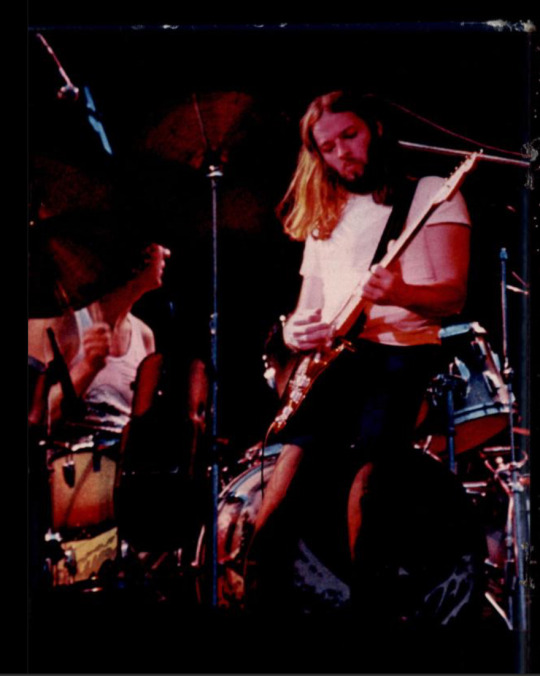
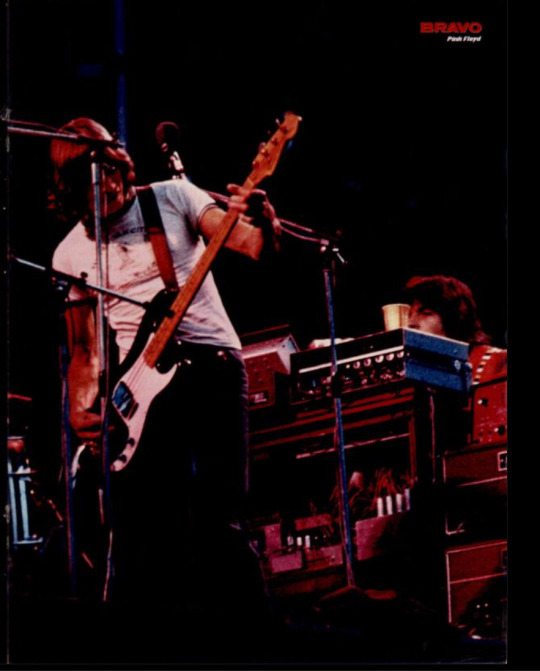
#Pink Floyd#rock photography#classic rock#60s#60s rock#70s#70s rock#roger waters#david gilmour#nick mason#rick wright#richard wright#syd barrett#rock history#music history#60s music#70s music#translation#magazine article#old magazines
43 notes
·
View notes
Text
Teen Titans Chronology
Era 1: Superhero Names & Funky Nicknames
The Brave and the Bold (1955) #54 The Brave and the Bold (1955) #60 Showcase #59 Teen Titans (1966) #1-20 The Brave and the Bold (1955) #83 Teen Titans (1966) #21-22
This is the peak silly era. Goofy nicknames, (mostly) goofy one-off villains, occasional team-up, etc. As far as I'm aware, none of their real names are ever mentioned within their own title and it's just their superhero names.
It starts with Robin, Kid Flash, Aqualad (in the first Brave and Bold), with Wonder Girl being the first addition when they are officially first called the Teen Titans (in the second Brave and Bold), so I'm counting the Fab Foursome (Cool Quartet? Fantabulous Foursome?) of them as the starting point. They're a team up to #18 with occasional guests from Speedy (#4 - with notes that there were an "avalanche of mail" asking for his inclusion, #11), Beast Boy (#6 - rejected by the Teen Titans and apparently previously the Doom Patrol for not having a guardian's permission slip, interesting note that he already had movie offers here), and Starfire (#18 - definitely not who you're thinking of and instead a Russian boy).
Issue #19 is when they become "Fab-Four-Sometime Five" where Roy joins and Garth takes a break, so the main four changed. There are then two more team ups with Jericho (#20 - also not who you're thinking of but some boy name Joshua) and with Hawk and Dove (#21).
I think only Mad Mod became a long-term villain (?) but the list includes: Mr Twister, the Astounding Separated Man, Beast-God of Xochatan, Akkuru, Ding Dong Daddy Dowd (Demon Dragster), Diablo, The Ant (less villain and more blackmailed by Mr Krask), Mr Baltzer, Mad Mod, Honey Bun (and a spy Karl Larner), Captain Tiger, The Scorcher, The Gargoyle (who makes a reappearance in #35), Captain Rumble, The Dimensional Caper (from Dimension X), Le Blanc, Punch (Sylvester Sepastopol), Fat Cat.
Era 2: Real Names, New Teammates, Mr Jupiter, and Solo Storylines
Teen Titans (1966) #22-31 The Brave and the Bold (1955) #94 Teen Titans (1966) #32-34 World's Finest Comics #205 Teen Titans (1966) #35-39 The Brave and the Bold (1955) #102 Teen Titans (1966) #40-43
This part of the story starts to have a bit more personality and it is a lot more character-driven as opposed to (short) plot-driven stories. Their real names are finally used and they're shown to hangout as civilians and not just superheroes.
This starts at the end of #22 when Donna Troy is given a name, a backstory (one of many), a new apartment, a roommate Sharon, and a makeover. Dick and Wally was previously named in #83 of The Brave and the Bold, but Roy gets named in #24. In a way, this makes Donna feel very much like the living center of the Titans for me, her development begins with the Titans and she's intrinsically tied to it very personally (and this also feels reflected in how Garth views Donna as the "TITANS FOREVER" among all of them). After all, at this point, there's no separate comics she is in unlike the other 4 main titans. She is also the only single character that appears in every single comic with no exception (other than the very first, but they weren't known as Teen Titans then either).
There aren't so much guests as much as two new permanent members - Lilith who joins right before Mr Jupiter comes into the picture in #25 and Mal who joins right after in #26. During this time, 6 of them are mostly all there and are led and trained by Mr Jupiter. The longest disappearance is when Dick goes to college (from #25-32 except for a single appearance in #28) and occasional disappearance when they stay behind to take care of Mr Jupiter's lab (sometimes it is unexplained but I chalk most disappearance up to this). From #26 onwards, all but 6 issues are not related to Mr Jupiter (#28-29 led by Garth, #31 led by Wally, #34 and #42 led by Donna, and #43). This era also seems to establish Wally (and Donna) as de-facto leader when Dick is not around.
All other guests are really more part-time members such as Hank and Don who do their summer stint from #25-#30, Gnarrk who first appears in #32-33 and comes back in #39, and Garth who appears in #28-29 and #40.
For the first time (as far as I'm aware), a known villain gets brought into the story - Ocean Master (Orm) and an alien leader Mofo in #28-29 with Garth going after him. This part also established the easy-to-get-into-fights, easy-to-get-out-of-fights (among themselves) dynamics that I associate with the Titans. They start to place more importance on their insecurities and friendship.
There are also 2 main "friends get brainwashed" (for extended period) type storyline during this period of time (which later seems to become quite commonplace among the Titans): once with Donna (#34 which Wally doesn't see) and once with Garth (#40).
This is also the only era which has quite a lot of additional separate solo storylines. It start with Donna if you count "The Origin of Wonder Girl" in #22 (although it's kind of more like an additional story where everyone appears), and then Wally and Garth (with Tula) in #30. Garth (#30, #35, #36, #38) and Lilith (#36, #38, #41, #43) have the most with 4 each, Roy (#35, #38) and Hank&Don (#31, #39) have two each, and Mal (#35) and Dick (#36) have one each (like Donna and Wally). Superboy (young Clark) actually also has two - one with Dick (#36) and one with young Ollie (#37) that doesn't even have any of the Titans in it.
Crucially, contrary to how modern comics love to portray Batman and Robin's view on the Teen Titans, Batman actually fully supports the Teen Titans in the original and has never been shown to do otherwise almost at all. In fact, he is the one with the most team-ups with the Teen Titans and the team-ups almost always happen because he needs helps "relating to the teens" and he specifically calls on them, with full respect for them (even purposely allowing Wally and Donna to punch him real hard that one time to solidify their cover). The only mentor who does show disapproval is actually Aquaman (in Era 3), who does so because Garth gets mysteriously sick which he blames on the Teen Titans (sort of half-correctly).
Interestingly, up to this point there are actually more team appearances of what I'm calling Alternative 5 or Alt5 (Wally, Donna, Roy, Lilith Mal) than of Fab5 (Dick, Wally, Donna, Garth, Roy). In fact, up to this point there were 12 appearances of Alt5 over 5 appearances of Fab5. This is mostly because Roy and Garth actually have very little team-ups because Roy became a permanent basically the same time that Garth stopped being a permanent member.
Titans Villains (other than Ocean Master hat one time) in this era: Hell's Hawks, Harry Tout, Dr Pauling, Councilman Buckminster (Santa Claus), Demoness possessing Magda Drachwyck (Miss Wickersham), Calibano Della Loggia (x2), Four Horsemen of the Apocalypse, Black Earl of Moray, Captain Barstow's Phantom, Lord Beetle
Era 3: When Fab5 was Defined, More Teammates, Teen Titans West, and Splitting Up
Teen Titans (1966) #44-53 The Brave and the Bold (1955) #149
There was a more than 3 years gap from the last issue #43 in February 1973 to issue #44 in November 1976 which translated to a 2 year in-comic hiatus of the Teen Titans. There's also a change of regular writer from (mostly) Bob Haney to Bob Rozakis. All this culminated in a change in tone of the characters being a bit more aggressive and antagonistic towards each other, especially with Roy (note: Snowbirds Don't Fly happened in 1971 so it's not because that occurred in between the break since it actually happened before the break). They fight a lot more this era and the storylines are longer and bleed more into one another.
Another obvious change is that Wally is shown to be way more into Donna than before (in his thoughts especially) instead of their more casual flirting. Wally does eventually confess to Donna who rejects him in this era. The other "official" relationships are Mal/Karen and Lilith/Gnarrk (funnily because Mal/Lilith was a thing for a bit).
In story, Mr Jupiter decides to close shop (unknown reason) and so they broke up, with Mal taking care of the labs and the rest pursuing their individual careers instead as they agreed upon (but Mal is unhappy about). This... doesn't really make sense because I'm not sure what "individual career" Donna has, but never mind.
Lilith is no longer in the main team (later explained that she settled in the West Coast with Gnarrk which is very contradictory to her last statement in #43 that the Teen Titans is her family). Garth comes back from #45 when he is mysteriously summoned by Mal's horn and it's like he never left. He wants to resign in #51 because his insecurities making him physically sick, but he agrees to finish the mission and they all ended up disbanding anyway. Karen appears first in #45 as Mal's girlfriend and joins as Bumblebee in #49, but Duela joins the team first in #46. Because of these lineup changes, Fab5 appearances started to catch up to Alt5 until eventually Alt5 (15 appearances) just barely edges out Fab5 (13 appearances). Interestingly, Dick-Wally-Donna-Roy-Mal actually end up appearing most (17 appearances).
They (it's honestly mostly Dick, Wally, and Donna) discuss the idea of a new headquarters first suggested by Donna in #45 (like I said, she's very much the living centre of the Titans). Dick makes the decision (because he is Leader-Man and Bruce is funding it) to have their headquarters as a restaurant front, Gabriel's Horn (named after Mal's horn given by the angel Gabriel in #45), run by Mal and Roy (the jobless duo apparently) in #46 and they set it up in #49. Mal and Roy also started forming the rock band The Great Frog (a job!) in #45 which plays in their restaurant.
Teen Titans West first meet up and is established in #50 with some familiar faces (Gar, Hank, Don, Lilith, Gnarrk) and some complete newbies (Bette, Ch'al) to the roster. Issues #51 and #52 have the East and West team up, resulting in basically every Titans ever joining with the exception of Tula (but then again, at this point she only appeared in Garth solo story and never in the main storyline). At the end of which, they have a big feast (sponsored by Dick) and decided to part ways to improve and work towards eventually becoming the future Justice League (as they were always meant to).
The final story #53 establishes their origin and formation story which includes Roy, but had Roy basically saying he wanted to be involved only whenever he wanted and not permanently (ahem commitment issues), establishing Fab5 as the clear founders of the Teen Titans in the last issue.
There is a third "friends get brainwashed/used" (for extended period) type storyline with Lilith (#50-52), except she's not evil, but her powers are manipulated for evil. With Duela, there is also the first instance of villain's children in the Titans (in future there is Joey and Rose most prominently), setting up the stage for Titans raising villain's children. They actually brought Two-Face in to visit Duela at least once (right after a crime too???) which is... interesting?
This era has many more appearances of known villains including Dr Light, The Fiddler, Two-Face, and Mr Esper (Captain Calamity). The final issue is where Antithesis first appear (he is a recurring villain or at least comes back in future issues), and the remaining unimportant ones are: The Wreckers, Flamesplasher (x2), Sizematic (x2), Darklight (x2), and Rocket Rollers led by Brian the Brain.
Finally, there are some unexplained mysteries. Where the hell did Mal's horn go since it went missing in #49? Who is the blonde "Little Queen" that Garth meets from #36 (because I don't think it's Nirka McDuff from #40)? Who are Lilith's parents? What's up with Mr Jupiter? Is he Donna's dad (#35)? Do they ever make use of the possibly haunted mansion and fortune they inherited in #43? Why did Mr Jupiter not bother to make Roy, Wally, and Lilith face their fears (#38)? Does he think redheads have no fears? Are we going to address the fact that Lilith is apparently Juliet reborn (#35-36) and decided to give up Romeo (who she was very enamored by for a while) for Gnarrk?
To be continued~
Some Statistics (For Fun)
Most to least appearances, we have:
Donna (60) - only missing from the very first story before they were coined the Teen Titans
Wally (58) - missing from 3 stories all during Mr Jupiter era (twice unknown reasons and once because he is watching the lab)
Dick (54) - missing from 6 issues for his college
Roy (41)
Garth (37)
Mal (28)
Lilith (22)
Mr Jupiter (12) - not a Titan but I was curious so I counted him
Hank and Don (11)
Karen and Duela (8)
Gnarrk (5)
Gar (4)
Bette and Ch'al (3)
Tula (1)
Most to least trio appearances (within Fab5):
Dick-Wally-Donna (50)
Wally-Donna-Roy (38) - the love triangle lmao
Dick-Donna-Roy (33)
Dick/Donna-Wally-Garth (32)
Dick-Donna-Garth / Dick-Wally-Roy trio (31) - DWDG and DWDR limiting factor
Wally/Donna-Garth-Roy (14) - Roy/Wally-Donna-Mal/Lilith have more than this (25, 23, 19, 18)
Dick-Garth-Roy (13) - Fab5 limiting factor
For quartets, Dick-Wally-Donna-Garth (DWDG) quartet (31) ends up exactly equal to Dick-Wally-Donna-Roy (DWDR) quartet (31).
Special note that because of Lilith separation in Era 3, even though Garth is brought back, the Rebirth "OG" line up (Fab 5 + Lilith) actually only has 3 appearances together. On the other hand, Alt 5 + Dick have 9 appearances (but no Garth). World's Finest line up (Fab5 + Karen) have 7 appearances but only 4 of which Karen is actually Bumblebee and fighting with them, while the Silver Age Final line up (Fab5 + Mal) has the most with 10 appearances.
Ultimately, Lilith does still make more sense to me than Karen to balance the team with more girls, because she definitely was there earlier, had more appearance than Karen, and also doesn't have the additional association of joining because of Mal since she predates Mal. That said, the girl with the most Fab5 teamup might actually be Duela who also has 7 appearances with Fab5, all of which she is on their side (although half their issue was trust which wouldn't make so much sense if she was with them from the beginning). The person with most Fab5 teamup is unquestionably Mal though (10). It's curious to see what is more "valid" but my personal opinion is that there is no point in making a Fab6 just let leave it be and acknowledge it as product of its time.
If you want to have a look at the data out of curiosity, it's here.
#teen titans#dick grayson#wally west#donna troy#garth of shayeris#roy harper#garfield logan#hank hall#don hall#lilith clay#mal duncan#karen beecher#duela dent#john gnarrk#bette kane#ch'al andar#tula of atlantis#robin#kid flash#wonder girl#aqualad#speedy#mypost#dc thoughts#uhhh donna and wally both having more appearances than dick somewhat surprised me#i started tracking bcos i got curious whether ultimately someone else will dethrone dick with more titans appearance#which i NEVER expect to be the case especially right from the start but i actually think donna will reign titans supreme#i think new (teen) titans will be when roy dethrones wally but will he dethrone dick? possibly!#i didn't bother with pairs comparison cos there's SO many BUT its def donna&wally > dick&donna > dick&wally#also hank complains that they never called him back after re-forming the titans which is never explained but you could put on robin lmao
51 notes
·
View notes
Text
Cancelled Missions: SA-11 through SA-14 (AS-106 through AS-108) Saturn I Block II

"September 1962 NASA planned to fly four early manned Apollo spacecraft on Saturn I boosters. Cancelled in October 1963 in order to fly all-up manned Apollo CSM on more powerful Saturn IB.
Launched: 1965 Winter. Number crew: 3 .
A key prerequisite for these flights was complete wringing out of the launch escape system.
The tentative Apollo flight plan laid out the following unmanned tests before a manned flight would be undertaken:
Pad abort: Two tests to simulate an abort on the pad. These tests would qualify the launch escape system
Suborbital (Little Joe II): Three suborbital tests to qualify the launch escape system and the command module structure. Tests would include maximum dynamic and high altitude conditions.
Orbital (Saturn C-1): Flights SA-6 (with SA-8 as backup) would determine the launch exit environment. SA-7, SA-9, and SA-10 would flight-test components of or the complete emergency detection system. Four manned flights would then commence with SA-11.
By January 10, 1963, MSC and OMSF agreed that an unmanned Apollo spacecraft must be flown on the Saturn C-1 before a manned flight. SA-10 was scheduled to be the unmanned flight and SA-11, the first manned mission.
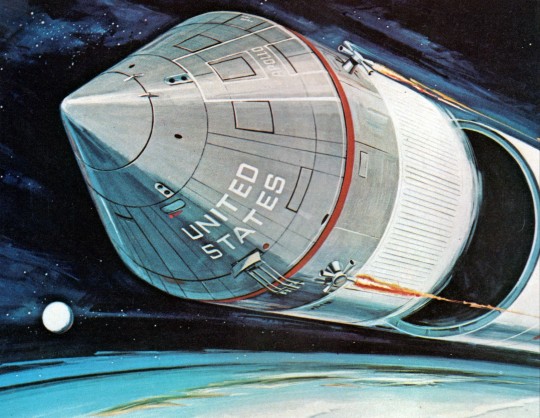
Early concept art of the Apollo Block I Command and Service Module separation from the S-IVB.
Image from Space Horizons Vol. No. 1, Issue No. 1 (1965)
By the later summer of 1963 the value of the Saturn I missions seemed increasingly in doubt. The limited payload of the Saturn I meant that only partial systems could be installed. At a September 26, 1963 meeting in Washington, D.C., NASA's scheduling contractor, Bellcomm, was asked to develop an Apollo mission assignment program without a Saturn I.
Bellcomm quickly responded, recommending that the Apollo spacecraft flight test program should be transferred from the Saturn I to Saturn IB launch vehicles. The Saturn I program should end with flight SA-10. All Saturn IB flights, beginning with SA-201, should carry operational spacecraft, including equipment for extensive testing of the spacecraft systems in earth orbit. Associate Administrator for Manned Space Flight George E. Mueller recommended the changeover on October 26. NASA Administrator James E. Webb's concurrence came two days later. Development of the Saturn IB for manned flight would be accelerated and 'all-up' testing would be started.
No crew assignments were ever made for these flights; the first two groups of astronauts were fully committed to the Gemini program. The third astronaut selection, in October 1963, was simultaneous with the decision to drop the Saturn I flights. Had these flights occurred, they would have run from fall 1965 to the end of 1966, concurrent with the flights of Gemini 5 to 12."
Cancelled missions:
SA-11 (AS-106): planned launch Winter 1965
SA-12 (AS-107): planned launch Spring 1966
SA-13 (SA-108): planned launch Summer 1966
SA-14 (AS-109): planned launch Fall 1966
-Information from Astronautix.com: link
Posted on Flickr by Numbers Station: link
#SA-11#(AS-106)#SA-12#(AS-107)#SA-13#(AS-108)#SA-14#(AS-109)#Saturn I#Saturn I Block II#Rocket#NASA#Apollo Program#Apollo-A#Apollo CSM Block I#1965#1966#Cancelled#Cancelled Mission#my post
56 notes
·
View notes
Text
Venus signs as supermodels
Aries

Paulina Porizkova (19°): signed the most lucrative partnership in 1988, a $6 million deal with Estee Lauder for seven years, the first Central European woman to appear on the cover of the Sports Illustrated swimsuit issue
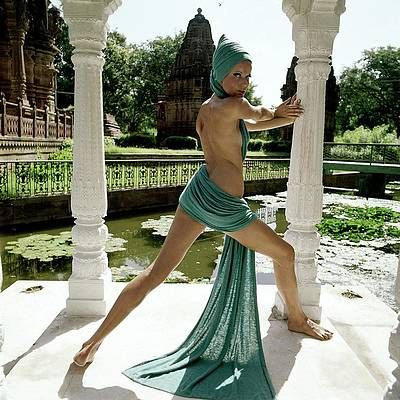
Vera Lehndorff (22°): known professionally as Veruschka, she is considered the "first German supermodel.
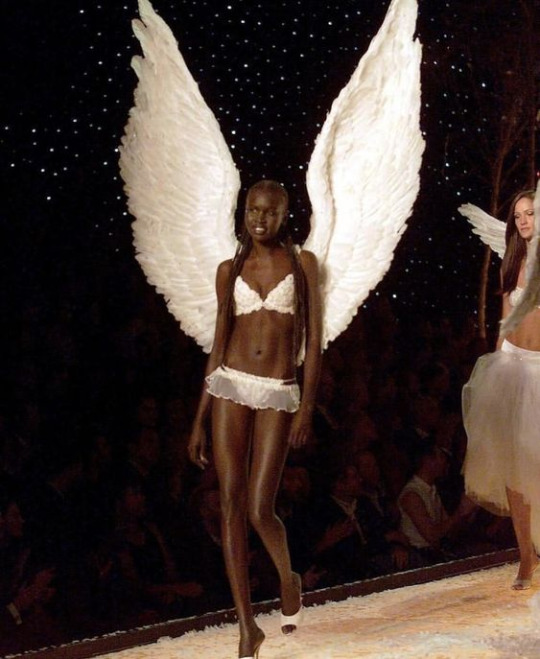
Alek Wek (10° R): began her modeling career in the mid-1990's, she became one of the most successful black model in the industry. She has been hailed for her influence on the perception of beauty in the fashion industry.
Taurus
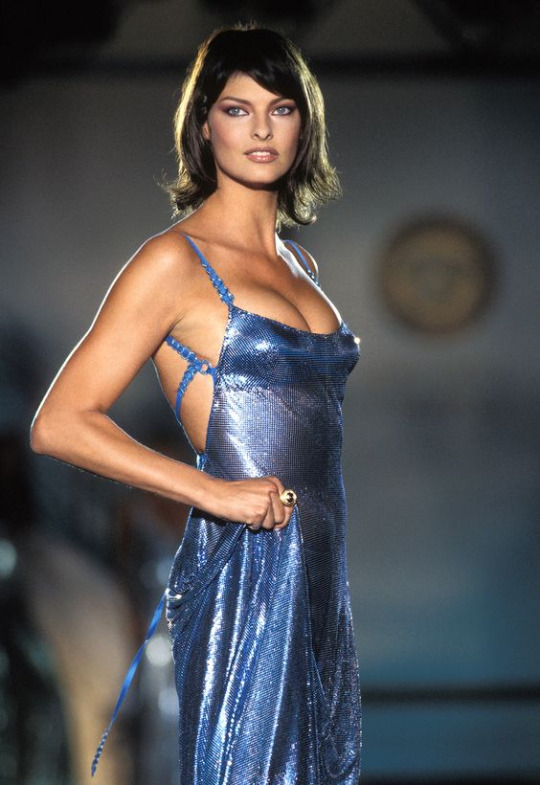
Linda Evangelista (27°): been featured on over 700 magazine covers, Evangelista is primarily known for being the longtime "muse" of photographer Steven Meisel, as well as for the phrase: "We don't wake up for less than $10,000 a day." Described as the "chameleon" of the fashion industry, she was part of the "Trinity". Known by her nickname "The Linda".
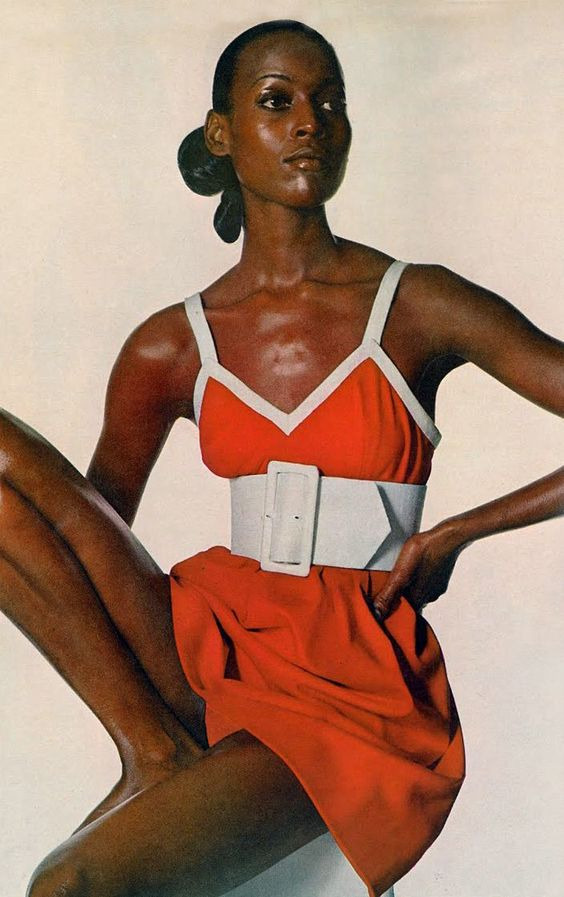
Naomi Sims (25° R): was the first African-American model to appear on the cover of Ladies' Home Journal, which occurred in November 1968, and is widely credited as being the first African-American supermodel.
Other supermodels: Carmen Dell'Orefice (16°), Jessica Stam (25°)
Gemini

Naomi Campbell (29°, V House): sleek, tall, chic, one of the reigning queens of jet-set supermodels, the first black female model to make the covers of both the British and French Vogue. She was part of the Trinity which also included Christy Turlington and Linda Evangelista.

Giselle Bündchen (19°, VI House): since 2001, she has been one of the highest-paid models in the world. Vogue credited her with ending the heroin chic era of modelling in 1999. In 2007, Claudia Schiffer called Bündchen the only remaining supermodel. She has appeared on more than 1,200 magazine covers.
Other supermodels: Joan Smalls (14°), Kimora Lee Simmons (24°), Heidi Klum (24°), Laetitia Casta (17°, IX House)
Cancer

Iman (7°): muse of the designers Gianni Versace, Thierry Mugler, Calvin Klein, Donna Karan and Yves Saint Laurent (who described her as "the dream woman").

Lisa Fonssagrives (4°): is widely credited with having been the first supermodel. She was reported as "the highest paid, highest praised, high fashion model in the business".
Other supermodels: Jourdan Dunn (16°, II House), Devon Aoki (25°)
Leo
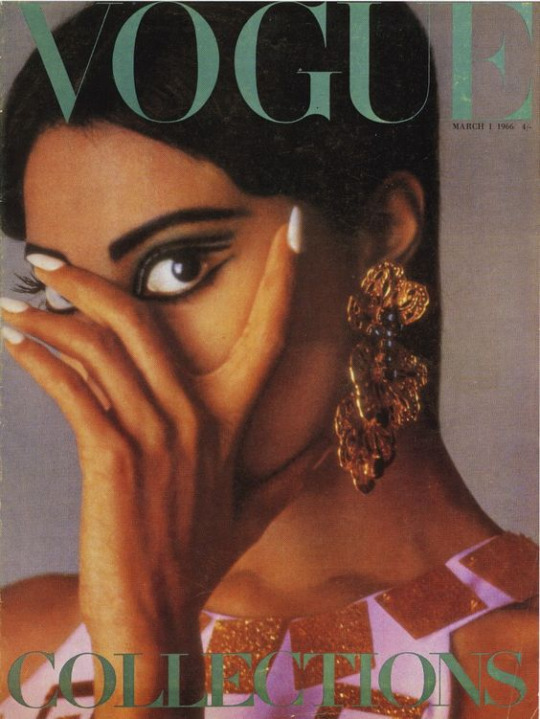
Donyale Luna (1°): the world’s first black supermodel; when she was 20 years old, Time magazine named 1966 as “The Luna Year,” describing the model as “a new heavenly body who, because of her striking singularity, promises to remain on high for many a season.”

Karlie Kloss (25°, II House): Models.com has said that Kloss "represents the gold standard of modeling—a girl with the look, the poise, and the drive to take things to the next level", and she ranks on their "New Supers" and "Money Girl" lists. By 2019, she had appeared on 40 international Vogue covers.
Other supermodels: Anja Rubik (6°, VIII House), Stephanie Seymour (9°, XII House), Coco Rocha (3°)
Virgo

Ines de la Fressange (19°, IV House): the first model who had an exclusive contract with a fashion house, Chanel. After her decision to accept the deal with the French government to be a model for the national symbol of Marianne, she had an argument with her mentor at Chanel, Karl Lagerfeld who considered her his muse. She terminated the relationship with the fashion house and has gone on to design for Gaultier.

Bella Hadid (6°, XII House): she began her modeling career in 2014 and walked in major fashion show for designers such as Chanel, Dior, and Marc Jacobs.
Libra

Lauren Hutton (8°, III House): signed a modeling contract with Revlon in 1973, which at the time was the biggest contract in the history of the modeling industry

Claudia Schiffer (17°, XI House): became the face of Guess, which gave her mainstream recognition. “In order to become a supermodel one must be on all the covers all over the world at the same time so that people can recognize the girls,” she once said. Appearing on more than 1,000 covers over the span of her career, Schiffer is listed in the Guinness Book of World Records as the model with the most magazine covers.

Beverly Peele (9° R): rose to fame in the late 1980s and 1990s, as a supermodel, appearing mostly in Mademoiselle and Elle magazine. She appeared on over 250 fashion magazine covers including Vogue and Harpers Bazar.
Scorpio

Twiggy (5°, IV House): with her expressive doe eyes, she was crowned “The Face of 1966,” voted British Woman of the Year, and found immediate fame all over the world.
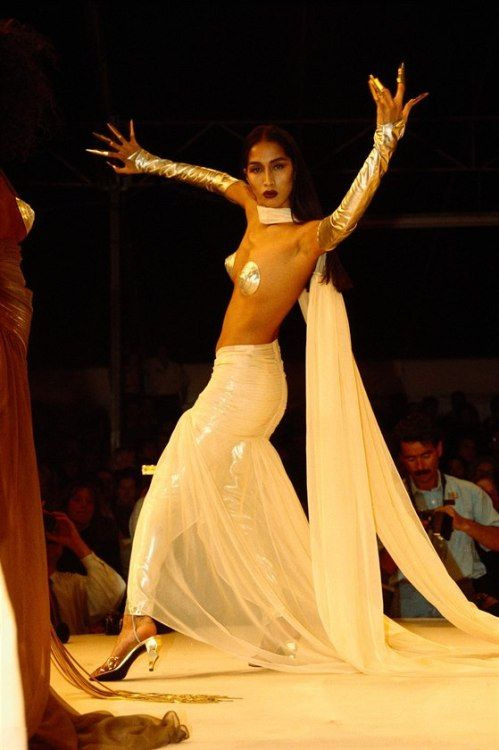
Anna Bayle (13°): became one of highest paid models in the late 70's. She has been described as being one of the first Asian supermodels (she's filipino). Bayle became known for her unique runway walk, which The New York Times described "as if she were crushing a cigarette butt with each step down the runway".
Other supermodels: Carla Bruni (19°, V House), Kristen McMenamy (23°), Milla Jovovich (12°, V House), Beverly Johnson (19°), Jean Shrimpton (10°, XII House)
Sagittarius

Kendall Jenner (0°, VIII House): her status as a supermodel is controversial. Jenner made her debut at No. 16 on Forbes magazine's 2015 list of top-earning models, with an estimated annual income of US$4 million. In 2017, Jenner was named the world's highest-paid model by Forbes, ousting model Gisele Bündchen, who had been leading the list for more than 14 years since 2002.
Capricorn

Tyra Banks (27°, VII House): the first black model to appear on the cover of a "Sports Illustrated" swimsuit issue and the first black woman to be featured on the cover of the "Victoria's Secret" catalog.

Cindy Crawford (28°, VII House): known for her trademark mole just above her lip. Her girl-next-door aesthetic was so in demand, she fronted nearly every campaign imaginable, from Calvin Klein to Pepsi.
Other supermodels: Amber Valletta (26° R), Irina Shayk (12°), Shalom Harlow (28°)
Aquarius

Barbara Goalen (23°, XI House): is considered the first British supermodel. With her striking features and wasp-waisted frame, she epitomised post-war glamour and modelled for both Dior and Balenciaga.
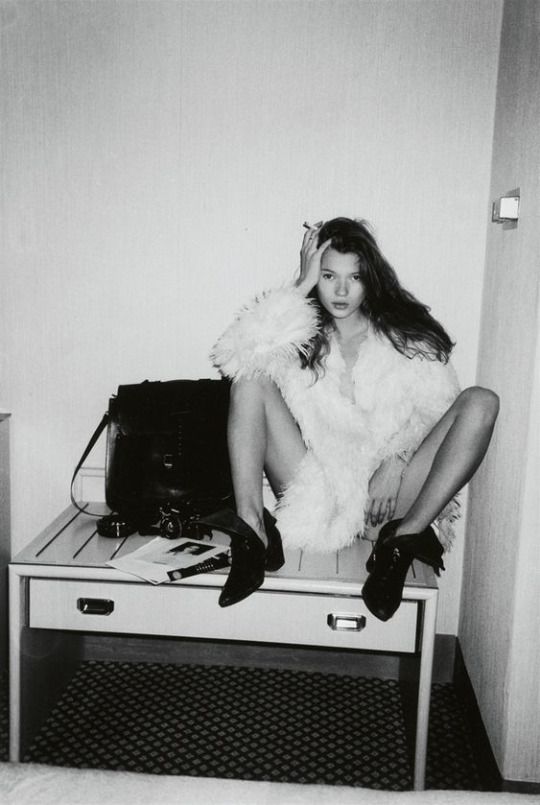
Kate Moss (7° R): rose to fame in the eary 90's as part of the heroin chic fashion trend. She is known for her waifish figure and role in side zero faschion. She has inspired cultural depiction including a 18 carat gold statue of her, sculpted in 2008 for a British Museum exhibition. She was part of the 'Big 6' together with Naomi Campbell, Christy Turlington, Linda Evangelista, Cindy Crawford, and Claudia Schiffer.
Other supermodels: Christy Turlington (27°, II House), Tatjana Patitz (18°), Yasmeen Ghauri (23°), Helena Christensen (17°, IV House), FeiFei Sun (21°)
Pisces

Liu Wen (14°): in 2012, The New York Times dubbed her "China’s first bona fide supermodel". She is the first Chinese model to walk the Victoria's Secret Fashion Show, the first East Asian spokesmodel for Estée Lauder cosmetics, and the first Asian model to ever make Forbes magazine's annual highest-paid models list, the first to be featured on the front cover of Vogue, the first person of Chinese descent to appear three times on Vogue.
#aries venus#taurus venus#gemini venus#cancer venus#leo venus#virgo venus#libra venus#scorpio venus#sagittarius venus#capricorn venus#aquarius sun#pisces venus#fashion
160 notes
·
View notes
Text
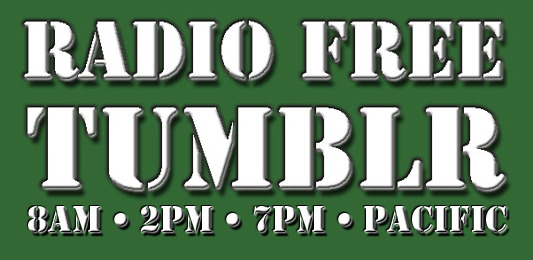
Monday, 11-11-24, 8am Pacific
G'mornin', folks...a groggy Mr. Baggins with you. I don't know about y'all, but I need at least two hours of coffee sipping and cogitation before I'm ready to face the world, so we're gonna start our mornings off with Morning Coffee Music: selections to entertain and energize. One of ths best radio DJs I ever listened to back in Austin, was John Aelli, on KUT in the mornings for literally decades. It's in his "anything goes" free-form spirit I start this first edition of Coffee Music.
In 1964, I was a five year old kid boppin' to this on the big old Zenith booming in the corner. Here's trumpeter Al Hirt and his 1964 hit, called appropriately enough, "Java".
youtube
Here's a little bit of Beatlefluff from 1966 guaranteed to have you humming along. From Revolver, here's Paul's "Good Day Sunshine".
youtube
Here's one of the two hits by the band "Vanity Fair"; from 1970 it's "Early In The Morning".
youtube
Rossini wrote six String Sonatas at the age of twelve. Here's our old friend Neville Marriner and the ASMF to play numbers 1 and 6, on an Argo recording. A friend once said that the first sonata could have easily been the soundtrack to a Leave It To Beaver episode, saying it sounds like "Breakfast with The Cleavers".
youtube
Glenn Gould's Bach is essential to any good morning! Here is his 1960 recording of Bach's "Italian Concerto", a more charmingly refreshing twelve minutes you won't find anywhere.
youtube
Moving from the modern piano to the harpsichord now, this is music by Franz Joseph Haydn, his Concerto in D Major. I've chosen the recording by the person responsible for the harpsichord's rebirth as a viable instrument in the early 20th Century, Wanda Landowska. This was recorded in 1937, Mme. Landowska is accompanied by conductor Eugène Bigot, with an unnamed orchestra.
youtube
Moving from Papa Haydn to his young protege, Ludwig Beethoven, we hear a very early work of Beethoven's, written when he was sixteen. It is counted among the works he wrote before his official Opus 1 was published, the "Works Without Opus" Number 37, Trio for bassoon, flute, and piano. This delightful little piece is performed by pianist Daniel Barnboim, flutist Michel Debost and bassoonist André Sennedat, from a 1980 recording on DG. It was this very recording that served as my introduction to the piece. I've had a copy of the original album since it was issued. Enjoy.
youtube
Next are some pieces played by oboist John Dee and The Tantallon Ensemble, from their album entitled "Under a Near Sky", which is, sadly not on YouTube in its entirety, so here are a couple of selections. First is Gabriel Pierne's "Piece an sol"
youtube
This is Franz Krommer's Quartet in C major
youtube
And this morning's final selection, one of my absolute favorite pieces of all time, and this version of it specifically. Here is Igor Stravinsky conducting his big bad 1945 revision of his brilliant "Firebird Suite". Recorded in 1946 on a Columbia Masterworks recording. Enjoy, and I will be back with you later this afternoon.
Until then, be kind, babies, be kind.
Baggins out.
youtube

13 notes
·
View notes
Text
"NOBLE HOUSE" (1988) Review
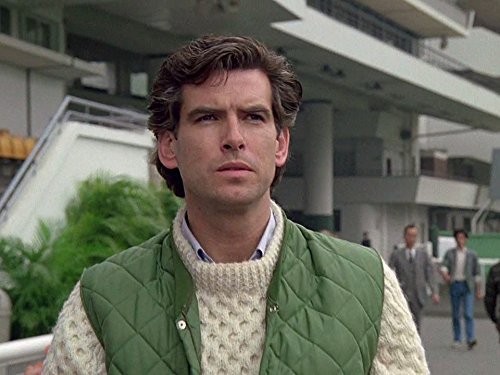
"NOBLE HOUSE" (1988) Review
Between 1962 and 1993, author James Clavell wrote and published a series of novels centered on Europeans living in Asia. Some of the novels featured a family founded by a Scottish-born sailor named Dirk Struan, who became a trader in early 19th century China. And one of those novels was "Noble House", published in 1981.
Clavell's novel centered around one of Struan's descendants, Ian Dunross, who struggled to save the family company from a precarious financial position left by the previous CEO or "tai-pan" in the British colony, Hong Kong. Dunross sought a partnership with an American billionaire named Linc Barlett of Par-Con Industries, in the hopes of rescuing Struan's from financial ruin and a possible takeover by his family's long-time rival, Quinlan Gornt of Rothwell-Gornt. However, matters grew worse for Dunross and the company when the oldest son of Struan's comprador, Philip Chen, sold both company secrets and "coin debt" in the form of one of four half-coins that was given to Dirk Struan 146 years ago, to Barlett. This enabled Barlett to seek a partnership with Gornt in the hopes of making a raid on Struan's. When Philip's son, John Chen, ended up kidnapped by a local street gang, the value of the "coin debt", which ended up in the hands of wealthy smuggler named Four Fingers Wu. And this left Dunross and Struan's vulnerable to another threat.
I first read "Noble House" in my early twenties. Looking back on it, I now realize it was a good thing I had read previously read Clavell's 1966 novel, "Tai-Pan" and saw the 1986 movie adaptation. If not, I would have found myself confused over the family feud that served as a backdrop to the Dunross-Gornt feud and the history of the "coin debt". This involved four half-coins given to Dirk Struan by a Chinese trader named Jinqua in "Tai-Pan", as repayment for the loan of silver. Any CEO or "tai-pan" of Struan's must fulfill the request, whether legal or illegal, to anyone who presents one of the half coins that Jinqua originally kept. I ended up enjoying the 1981 novel very much. But I had some issues with it. Issues that had thankfully failed to materialized in "NOBLE HOUSE", the 1988 miniseries.
One of the issues centered around secret intelligence documents that Dunross found himself in possession of, thanks to his MI-6 contact. These documents ended up being sought by various intelligence agencies, including the MI-6, the C.I.A. and the K.G.B. However, this story arc had nothing to do with Dunross's efforts to save Struan's, so screenwriter Eric Bercovici ditched it. He also removed another story arc featuring an entourage of visiting members of Parliament - which included Dunross' Labor brother-in-law. Again, this arc had very little to do with the main one involving Dunross's business situation.
The miniseries had also removed several characters, including K.G.B. agent Captain Suslev, a visiting author and former Royal Air Force veteran named Peter Marlowe (from the 1962 novel, "King Rat"), Dunross's wife and children (he is a childless widower in the miniseries), Dunross's brother-in-law Robin Grey (also from "King Rat") and especially Dunross's wife Penelope and their three children. In the miniseries, Dunross is a childless widower, enabling him to have a romance with Par-Con executive Casey Tcholok. The biggest change proved to be the story's timeline. Bercovici updated the story's setting from August 1963 to November 1987, allowing it to be a modern tale. This enabled several characters like Linc Barlett and Casey Tcholok to mention Great Britain's future 1997 handover of Hong Kong to China.
I do have some minor complaints regarding "NOBLE HOUSE". One, I found Paul Chihara's score for the miniseries unmemorable and almost pedantic. And speaking of the score, I really disliked the cheesy aspect of the theme Chihara had created for the Orlanda Ramos character. It almost sounded like something for a soft-porn movie. Very insulting for a character like Orlanda, who proved to be more complicated. I also had a problem with some of the dialogue featured in "NOBLE HOUSE". This especially seemed to be the case in scenes featuring dialogue between European and Chinese characters or simply between Chinese characters. I found the dialogue rather awkward, exaggerated and very stylized. I realize the screenwriter was simply copying some of James Clavell's dialogue from the novel. But I really wish he had not.
Despite my complaints, I really enjoyed "NOBLE HOUSE". Every time I watch it, I am always surprised at how epic it seemed by the end of the last episode. And mind you, this story had very little to do with history. It was simply a mixture of the usual melodrama involving sex, romance, financial dealings and family conflicts. Even one of the story arcs, which featured Cold War espionage, managed to have an impact on the narrative's main arc regarding Ian Dunross's financial situation. Most people would be disappointed that this television adaptation was not completely faithful to Clavell's novel. Frankly, I am relieved. Bercovici managed to cut some of the superfluous story arcs and prevent the miniseries from becoming bloated. Yet, he still managed to retain Clavell's epic feel for the narrative. And he achieved this with the help of director Gary Nelson, who provided an overall steady pace in scenes that range from dramatic and action moments. Nelson's handling of the floating restaurant fire and the landslide that destroyed an apartment complex in the final episode really impressed me.
"NOBLE HOUSE" proved to be one of those productions that featured an international cast. Aside from a handful of performances, most struck me as being pretty solid. I must admit that I found those from the likes of Burt Kwok, Lim Kay Tong, Gordon Jackson, Denholm Elliott, Lisa Lu, Michael Siberry, Tia Carrere, John Houseman, Brian Fong, Ric Young, John van Dreelen, Nancy Kwan, Damien Thomas, Galen Yuen, George Innes and Dudley Sutton rather memorable. But there were certain performances that I truly enjoyed.
One of those performances came from the always memorable Khigh Dhiegh, who struck me as very colorful as one of Hong Kong's premiere smugglers, Four Fingers Wu. Ben Masters' take on the Lincoln "Linc" Bartlett characters seemed less boyish and more mature that Clavell's literary version. And to be honest, Masters' interpretation struck me as a lot more plausible as the witty and ruthless corporate CEO. I am more familiar with actor Ping Wu, thanks to his frequent appearances on NBC's "SEINFELD". But I really enjoyed his performance as Four Fingers Wu's youngest son, the intelligent and frustrated Paul Choy, who seemed incapable of impressing his father with his more modern outlook on how to profit outside of smuggling. Julia Nickson gave a very poignant performance as Orlanda Ramos, a local Eurasian television journalist and former mistress of Quillan Gornt. Thanks to Nickson's skillful performance, Orlanda evaded the superficial trope of a one-dimensional, walking sex toy; who became an intelligent, yet emotional woman who desired to be more than someone's bed warmer.
I might as well confess. Despite James Clavell's efforts, the character of Quillan Gornt never became a favorite of mine. His role as Dunross's main rival had nothing to do with my attitude. But I cannot deny that John Rhys-Davies gave one hell of a performance as the ruthless CEO who seemed to radiate wit, presence and a penchant for petty behavior. Casey Tcholok seemed like a difficult character to portray. Actress Deborah Raffin could have easily portray her as this ideal, "Mary Sue" type. Fortunately, James Clavell never portrayed Casey in that manner and neither did Raffin. Although the latter's take on the character seemed a bit more mature than her literary counterpart, Raffin expertly conveyed many of Casey's nuances - her razor-sharp intelligence, impatience, her talent for observation, her fears of being overlooked as a more than competent business person and her wit. However, Raffin's Casey struck me as a bit more sardonic than Clavell's literary version. Pierce Brosnan looked nothing like the literary Ian Dunross. Although both are tall, the latter possessed slightly wavy blond hair and the actor is definitely a brunette. The literary Dunross was in his early 40s, whereas Brosnan was only 34 years-old when he shot "NOBLE HOUSE". And yet . . . the Irish-born actor more than lived up to the role of Struan's CEO with a commanding performance without trying to hard. Brosnan wore the role very well - tight on the inside and relaxed on the outside. He not only portrayed Dunross's intelligence and ruthlessness with great skill, but also conveyed the CEO's growing concerns over losing the company and desperate attempts to save it without resorting to any kind of histrionic acting. By the time the miniseries ended, Brosnan had embedded into the role so well that I had completely forgotten that he was the wrong age to portray Dunross and possessed the wrong hair color.
"NOBLE HOUSE" never really acquired the acclaim that both television versions of James Clavell's 1975 novel, Shōgun or the movie version of the author's 1962 novel, "King Rat" had. But thankfully, it was no "TAI-PAN". Not that I care. I am not claiming that "NOBLE HOUSE" was mediocre. On the contrary, I thought it was a skillful and excellent adaptation of the 1981 novel. The latter is my favorite Clavell novel and I was more than happy that NBC had did more than simply justice to it, thanks to Gary Nelson's well-paced direction, Eric Bercovici's tight screenplay and performances from a first-rate cast led by Pierce Brosnan and Deborah Raffin. It has been years since I first saw it and to this day, I have yet to grown tired of it.

#james clavell#noble house#noble house 1988#asian saga#tai-pan#british empire#pierce brosnan#deborah raffin#ben masters#john rhys davies#ping wu#burt kwok#gordon jackson#nancy kwan#julia nickson#john van dreelen#hong kong#kay tong lim#damien thomas#lisa lu#ric young#denholm elliott#khigh dhiegh#dudley sutton#tia carrere#john houseman#michael siberry
3 notes
·
View notes
Note
hi :) i am a training historian focusing heavily on art, and i saw your post about ancient rome on my timeline, and i just wanted to say a few things about your “why we don’t have black art.” of course, you did not ask for this, it just sparked some thoughts and i figured i would drop by and say hello! <3
but if you want to learn some more, here are my two cents xx
1. we’ve only excavated roughly 10ish percent of “ancient rome”. there is a LOT left to discover. the issue with archaeology is that it is very expensive and very laborious, and it takes a long while to reap any sort of reward.
2. back in the 19th and 20th centuries, safe excavation practices were pretty nonexistent, we didn’t have the ‘rule book’ that we do now, so to speak. there are stories of archaeologists using dynamite to dig- so, a lot of stuff has been lost to negligence and ignorance to proper ways of excavating. (it still happens today!) for example, a lot of egypt was excavated by random people, too! not trained archaeologists and historians. for a while, richer folks wanted to have hands on experience with history, so in the early 20th century that’s what they did. (i don’t blame them, i probably would too if i had a shit ton of money!)
3. rome was also notorious for flooding- it’s not on a very nice location geographically. even today, many parts of italy have flooded, destroying hundreds of art pieces and artifacts. (such as the great flood in florence, which happened in 1966) a lot of artifacts are lost to natural disasters.
4. a lot of stuff just doesn’t survive. the fall of rome happened in 476 AD, and that’s over 1500 years ago. an issue i have also discovered is that a lot of surviving tablets and letters from the ancient world are just…. receipts and lists. nothing juicy. they were just normal people, you know?
5. a lot of art from rome could also have been lost to religious wars during the middle ages. that is an academic speculation, but culture is typically the first to go during a religious war or crusade.
6. also, roman art was fragile. all art is. we have lost a multitude of great paintings and pottery because it doesn’t last very long. a big example of this is someone a bit more recent than rome- Da Vinci. He experimented a LOT with types of paintings and techniques. his last supper painting began deteriorating just a few years after he painted it, because he tried to do a well fresco using oil paints. (not good lol) art is not forever, unfortunately, so i can imagine a lot of roman pottery not lasting very long with how fragile it is.
also, one last thing. i think we tend to group ancient societies into one large homogenous blog, and i find that very modernist and dangerous. ancient rome was full of different dialects, people, and groups, and to say they were all one thing it very dangerous. same for ancient greece- it was made up of various tribes! sparta was not athens, etc etc.
i believe that that goes for all history, as well. even well up into the 20rh century.
racism, as we know it, is a fairly newer concept in the historical time line. a lot of slavery back in the ancient world was based on status and wealth, or who was better at fighting, and not necessarily skin color. (still absolutely horrible though. obviously!)
for example, ancient egypt was, as new evidence suggests, a thriving society with multiple people from multiple backgrounds. (we’ve discovered tombs with people who all have different types of skin colors, insinuating that the most important people in their society were made up of a rather inclusive bunch.) and the same goes for north africa, today and then- it is a beautiful and diverse part of the map, and not one country is the same, and neither are their people!
the world is not made up of horrible people, and i think it would do us all some good to remember that. there is more love than hate, there always has been, and we can see it in art throughout time <3 ah, but i digress!
anyways, I have put some beautiful ancient art below depicting people of color. the first one is my fave! xxx




Hell yeah, thank you so much for this input!!!
(I have a lot of feelings about the era of the “I have money and no idea what I’m doing, I’m going to go eat a mummy.” Or “I’m going to go find Troy and inadvertently contribute to the Nazi platform.” (On that note, if you find that article interesting, I highly suggest these episodes of Behind the Bastards on the history of the swastika (part 1, part 2). Because at one point it really was just a symbol that like, every civilization on earth used at one point or another. And then a bunch of racist antisemites had to go and ruin it.) But seriously, Europeans loved eating mummies. Or using them in paint. And generally just destroying priceless artifacts for funsies. It infuriates me much the same way the fact the library at Alexandria was burned infuriates me, y’know?)
But I super agree with you vis a vis the fact we tend to paint “Ancient Rome” and similar societies/empires as a monolith. I mean… here hang on

It goes without saying that today, Spanish culture is different from French is different from British, Italian, Greek, Turkish, Algerian, Egyptian, Palestinian, etc etc etc. And that still would’ve been the case at this point. Sure there was influence (and later, it’s hard to escape the influence of the Catholic Church) but it’s not like Roman soldiers showed up one day in all these different places and replaced the whole local culture with marble columns and olive oil. (I mean, there was probably a lot of olive oil, but that’s besides the point)
I would still argue that there is probably a reason that we don’t see as much Roman-era art of Black people as we probably could, and whose fault that is I don’t know—it could be modern curators, it could be those 19th/20th century “archaeologists,” it could be neither and just pure chance—but I am here right now begging people that if you’re writing in this era, think for a few seconds before you pull all of your inspiration from rows of Roman statues portraying white people. (Also, if I’m remembering correctly, those statues were painted some pretty wild colors at their height, which is neat)
ANYWAY, thank you for the extra info !! I appreciate your expertise on the matter :0 thank you very much for sharing!!
5 notes
·
View notes
Photo

Character Actor
Henry Corden (born Henry Cohen; January 6, 1920 – May 19, 2005) Film, stage, television and voice actor, best known for taking over the role of Fred Flintstone after Alan Reed's death in 1977. His official debut as Fred's new voice was in the 1965 Hanna-Barbera record, Saving Mr. Flintstone although he had previously provided the singing voice for Reed in the 1966 theatrical film The Man Called Flintstone and the Hanna-Barbera specials Alice in Wonderland or What's a Nice Kid Like You Doing in a Place Like This? (1966) and Energy: A National Issue (1977). He took over the role as Fred Flintstone full time starting with the syndicated weekday series Fred Flintstone and Friends for which he provided voice-overs on brief bumper clips shown in-between segments.
He appeared in dozens of TV shows, including Hogan's Heroes (in five episodes), Dragnet, Perry Mason, Peter Gunn, McHale's Navy (in five episodes), Gunsmoke, The Mary Tyler Moore Show and was a regular on The Jerry Lewis Show. Corden was on Wagon Train, S3 E23, The Alexander Portlass Story (portrayed by Peter Lorre) as Phelan, one of Alexander’s crew. Corden also played landlord Henry Babbitt on The Monkees and Mr. Haskell, the owner of an ice cream parlor, in an episode of The Brady Bunch. (Wikipedia)
IMDb Listing
3 notes
·
View notes
Text
https://calmatters.org/commentary/2019/01/gavin-newsoms-keeping-it-all-in-the-family/?s=09
Gavin Newsom’s keeping it all in the family

BY DAN WALTERS
JANUARY 6, 2019
This story is part of California Voices, a commentary forum aiming to broaden our understanding of the state and spotlight Californians directly impacted by policy or its absence. Learn more here.
Gavin Newsom will be the first Democrat in more than a century to succeed another Democrat as governor and the succession also marks a big generational transition in California politics.
A long-dominant geriatric quartet from the San Francisco Bay Area – Gov. Jerry Brown, Sens. Dianne Feinstein and Barbara Boxer and House Speaker Nancy Pelosi – has been slowly ceding power to younger political strivers.
Moreover, Newsom is succeeding someone who could be considered his quasi-uncle, since his inauguration continues the decades-long saga of four San Francisco families intertwined by blood, by marriage, by money, by culture and, of course, by politics – the Browns, the Newsoms, the Pelosis and the Gettys.
The connections date back at least 80 years, to when Jerry Brown’s father, Pat Brown, ran for San Francisco district attorney, losing in 1939 but winning in 1943, with the help of his close friend and Gavin Newsom’s grandfather, businessman William Newsom.

Ties among the Brown, Newsom, Pelosi and Getty families date back three generations. Click on image for a larger view. Graphic for CALmatters by Nazneen Rydhan-Foster.
Fast forward two decades. Gov. Pat Brown’s administration developed Squaw Valley for the 1960s winter Olympics and afterward awarded a concession to operate it to William Newsom and his partner, John Pelosi.
One of the Pelosis’ sons, Paul, married Nancy D’Alesandro, who went into politics and has now reclaimed speakership of the House of Representatives. Another Pelosi son married William Newsom’s daughter, Barbara. Until they divorced, that made Nancy Pelosi something like an aunt by marriage to Gavin Newson (Nancy Pelosi’s brother-in-law was Gavin Newsom’s uncle).
The Squaw Valley concession was controversial at the time and created something of a rupture between the two old friends.
Become a CalMatters member today to stay informed, bolster our nonpartisan news and expand knowledge across California.
William Newsom wanted to make significant improvements to the ski complex, including a convention center, but Brown’s Department of Parks and Recreation balked. Newsom and his son, an attorney also named William, held a series of contentious meetings with officials over the issue.
An eight-page memo about those 1966 meetings from the department’s director, Fred Jones, buried in the Pat Brown archives, describes the Newsoms as being embittered and the senior Newsom threatening to “hurt the governor politically” as Brown ran for a third term that year against Ronald Reagan.
Pat Brown’s bid for a third term failed, and the Reagan administration later bought out the Newsom concession. But the Brown-Newsom connection continued as Brown’s son, Jerry, reclaimed the governorship in 1974. He appointed the younger William Newsom, a personal friend and Gavin’s father, to a Placer County judgeship in 1975 and three years later to the state Court of Appeal.
Justice Newsom, who died a few weeks ago, had been an attorney for oil magnate J. Paul Getty, most famously delivering $3 million to Italian kidnapers of Getty’s grandson in 1973. While serving on the appellate bench in the 1980s, he helped Getty’s son, Gordon, secure a change in state trust law that allowed him to claim his share of a multi-heir trust.
After Newsom retired from the bench in 1995, he became administrator of Gordon Getty’s own trust, telling one interviewer, “I make my living working for Gordon Getty.” The trust provided seed money for the PlumpJack chain of restaurants and wine shops that Newson’s son, Gavin, and Gordon Getty’s son, Billy, developed, the first being in a Squaw Valley hotel.
Gavin Newsom had been informally adopted by the Gettys after his parents divorced, returning a similar favor that the Newsom family had done for a young Gordon Getty many years earlier. Newsom’s PlumpJack business (named for an opera that Gordon Getty wrote) led to a career in San Francisco politics, a stint as mayor, the lieutenant governorship and now to the governorship, succeeding his father’s old friend.
He’s keeping it all in the extended family.
#THE BROWN NEWSOM GETTY AND PELOSI FAMILIAL DYNASTY RUNNING CALIFORNIA FOR OVER 80 YEARS#Gavin Newsom#Nancy Pelosi#DIRTY DEMOCRATS
4 notes
·
View notes
Photo

Tokitae Tribute C. 1966-2023
It's been over a year since Tokitae's death in August and I made this piece as a tribute. I originally intended to make this drawing back in 2023 when she first passed, but because of irl things, I kept it in my backlog until a few weeks ago when I began working on it again. Some info about Tokitae: There was this ploy back in 2023 to take Tokitae (her name is technically Lolita) out of her unethical environment at the Miami Seaquarium of 50 plus years and return her back to her waters of origin, the puget sound off the coast of Washington State. Despite her declining health, the media claimed that she was very healthy and fit enough for the journey back. There was also the claims that there was going to be a seapen being built for her and that sort of thing. This campaign was played on the media for 6 months until August of 2023 when she passed away. During the ploy, the Lummi Nation Tribe from Whatcom County Washington were all for the return and they named her, Ska'aliC'ehl-tenaut, which meant female orca. They were also waiting for her and even went to Florida to spiritually connect. They also had a campaign themselves to try to bring her home so when the ploy was announced, they participated. Of course, that would all change in August 2023 when Tokitae was found dead in her pool. She was found to have died of renal failure, something that she had for a long time. I personally think that the campaign would've never worked because I knew she was unhealthy. She was captured in Penn Cove in 1970 in the puget sound and apart of the L-Pod, she is believed to be the calf of Ocean Sun L25. She was estimated to be 3-6 years old, so her age was unknown but it's believed that she was born in 1966, although some people think she was born in 1964. She got sold to Miami Seaquarium in Miami Florida where she would live most of her life. She also had a tank mate, Hugo, but in the early 1980's, Hugo died from a brain aneurysm due to repetitively hitting his head against the glass and concrete. Leaving her the only orca in her small enclosure, the only company she had were pacific white sided dolphins. By the time of her death in 2023, she was the last surviving Southern Resident Orca in captivity. She died on August 18th, 2023. As of September 2024, she's been deceased for a year and one month. After her death, she got cremated and her ashes got flown back over to Washington State to get spread in her home waters. A ceremony was held and the Lummi Nation tribe spread her ashes back into her home waters. So she did get to go back home, but post mortem. No pro or anti-captivity in the comments, please. I personally believe that orcas don't do well in captivity and there should never be another orca in captivity again, but that's never going to happen. But I still don't want to argue about this issue.
Posted using PostyBirb
#orca#killerwhale#tokitae#lolita#she is now free forever#rip tokitae#I feel like everyone failed her#tribute
2 notes
·
View notes
Text
5. Batman and his Transmedia success
Batman is one of the most icon superheroes to emerge in the history of media. He first appeared in the May Issue of Detective Comics in 1939. Although he didn't get a standalone comic until 1940 with the title "Batman". (Transmedia Case study E, 2014)

[figure 1] Batman's First appearance in DC comics, May, 1939 Issue cover page
From this point, Batman kept becoming more and more famous with every issue of his comic, quickly gaining popularity and rising to the top. With its success, we see that his universe was already starting to expand through Transmedia. Batman travelling across its country of origin ie USA. In the 1960s Batman made its first appearance in Finland and quickly gained fame amongst children. The Finnish Batman was slightly different from the Batman in the US. It showed some element of comedy and fun. Batman adapted few elements according to the Finnish audience while managing to keep the core essence intact. It was one of its earliest success through Transmedia. They also introduced a "batman" soft-drink in Finland.( Laura. A, 2024).

[figure 2] Batman in Finland 1960
In 1966 Batman also had his first feature film and a TV series (1966 - 1968). Batman had become one of the highest selling superhero for DC.


[figure 3 and 4] Batman 1966 Movie poster (left) Series poster (right)
Due to its immense popularity, the franchise kept expanding with time and technology. The animated series of Batman (1968) was a big success and was followed by Batman the animated series (1992) and a global hit. There were plenty more animated series which followed. Each exploring new mediums, adding and expanding the universe of Batman (including a lego version).
youtube
Batman: Evolution (Animated TV Shows and Movies) - 2019 (80th Anniversary) by Renash30
Interactive Media Platforms such as video games, Mobile games , playstation or Xbox, every single one of them has a Batman game designed for it. The detective storyline through most of its adaptations, keeps the audience hooked. (Jesse. S, 2022) In 2024, there was also a trailer released for a VR that lets you play as Batman called "Batman: Arkham Shadow"

[figure 6] Batman in Arkham game series
youtube
The New Batman VR Game , Batman : Arkham Shadow (2024)
Batman is also highly known for his merchandises and figurines. At Present, Batman is present everywhere and only growing. From Comic books to Cinemas to Games , animation and merchandises, Its all available! In the DCU Cinema, Batman has received success in multiple standalone films such as Batman Begins (2005), The Dark Knight (2008), The Dark Knight Rises (2012) as well as relevant appearance in films like Justice League (2017) etc. Recently there was another film, The Batman (2022) which goes to show that Batman remains active in every media platform that it touched throughout its evolution.

Different representations of Batman (Jordan King, 2023)
But what makes Batman stand out? Why did it succeed so much that even after 70 years of his first appearance, people still want to see more? The answer could be that, in a world of superhero comics, Batman does not have any mutation, superpower or any innate physical superiority. He is an ordinary man who takes his human abilities to the peak in all possible areas because of the pain he had to go through. In short he is an ordinary person who wants to turn his pain or trauma into something positive. (Jordan King, 2023)The storyline has a lot of unique villains , fairly dark storyline and amusing twists and turns as it being a detective series.
Even after seven decades, the relevance of this character and the acceptance it receives from the audience still remains fervent. In Short, the ability to adapt and connect with the audience and with time, makes Batman as a franchise truly special and a top example of a successful Transmedia franchise.(Jordan King, 2023)
Bibliography:
Transmedia Case study E. (2014) Transmedia. Available at: https://wbs99190.wordpress.com/transmedia-case-study-e/ (Accessed: 05 January 2025).
King, J. (2023) Why Batman is cinema’s greatest superhero, Empire. Available at: https://www.empireonline.com/movies/features/why-batman-is-cinemas-greatest-superhero/ (Accessed: 05 January 2025).
Antola, L. (2024) ‘Holy transmedia! - the many faces of Batman in 1960s Finland’, Continuum, 38(4), pp. 532–547. doi: 10.1080/10304312.2024.2340009.
Batman (1966) IMDb. Available at: https://www.imdb.com/title/tt0059968/ (Accessed: 05 January 2025).
Batman: The movie (1966) IMDb. Available at: https://www.imdb.com/title/tt0060153/ (Accessed: 05 January 2025).
Renash30 (2019) Batman: Evolution (Animated TV Shows and Movies) - 2019 (80th Anniversary), YouTube. Available at: https://www.youtube.com/watch?v=uFm6EuLjU7Q (Accessed: 05 January 2025).
Schedeen, J. (2022) The Long Road to perfecting Batman in video games, IGN. Available at: https://www.ign.com/articles/batman-video-games-history-arkham-asylum-telltale (Accessed: 05 January 2025).
Kennedy, L.S. (2014) :: Batman arkham asylum, city, origins & knight, Steam Community. Available at: https://steamcommunity.com/sharedfiles/filedetails/?l=german&id=267413550 (Accessed: 05 January 2025).
1 note
·
View note
Note
Since Dark Crisis was a massive critical and financial failure when do you think we can realistically expect a new YJ book (or Teen Titans book staring them)
Okay, I will explain my reasoning under the cut, but my guesstimate would be around 2 years post-Dark Crisis: Young Justice before getting something new featuring them—whether it be Teen Titans or Young Justice though, I could not say.
Now, rather than just pulling a number out of my ass, my immediate response to getting this question was to look at publishing patterns/trends when it came to Young Justice and Teen Titans books.
I was using cover date information from the DC wiki for this, so not the most foolproof/precise data set in the world, but enough to give me a general idea.
The first thing I wanted to look at was, more broadly, what sorts of gaps there were with NO Teen Titans or Young Justice book since those teams came to be.
This is because presently, while we do have a Titans book, we do not have a Teen Titans book. As much as those are obviously related, they do serve/feature characters of different demographics, so I was looking specifically at the things categorized as 'Teen'.
The only exception to this is The New Teen Titans Vol. 2 because the book remains with the same team but switches names to 'The New Titans' partway through—it wasn't a relaunch of the book with an older team though, just a rebrand/name change as the characters had aged. It is still widely considered the same run, so I felt separating it (when we're talking about DC's publishing standpoint) didn't make sense.
ANYWAYS, their run years are as follows:
Teen Titans Vol. 1: 1966-73, 1976-78
The New Teen Titans Vol. 1: 1980-84
The New Teen Titans Vol. 2: 1984-96
Teen Titans Vol. 2: 1996-1998
Teen Titans Vol. 3: 2003-2011
Teen Titans Vol. 4: 2011-2014
Teen Titans Vol. 5: 2014-2016
Teen Titans Vol. 6: 2016-2021
Teen Titans Academy: 2021-2022
As is perhaps evident, the only gaps are between 1974-1975 (hiatus during Teen Titans Vol.1), 1979 (between Teen Titans Vol. 1 & New Teen Titans Vol. 1), and 1999-2002 (between Teen Titans Vol. 1 and Teen Titans Vol. 2).
The largest of those being four years (1999-2002)... but those years are covered by Young Justice's initial run!
The Young Justice runs (in main continuity, not counting tie-ins for the cartoon) are as follows:
Young Justice Vol. 1: 1998-2003
Young Justice Vol. 3: 2019-2021*
Dark Crisis: Young Justice: 2022-2023*
*To reiterate for clarity because I imagine some of you are going 'huh? DC:YJ was 6 issues all in 2022!' I'm using cover dates for consistency with this data—since the final issues of YJ Vol. 3 & DC:YJ each came out late in 2020 and 2022 respectively, their cover dates place them at the start of the next calendar year
So, putting all of that together, that means that ever since DC Comics began publishing Teen Titans books in 1966, the longest period with neither a Teen Titans nor Young Justice book being published was 2 years, between 1974-1975.
However, that doesn't tell the full story to answer your question about when we could expect to see the Young Justice kids again, it's just a helpful gauge about books in their 'teen' character age demographic.
To clairfy: by 'Young Justice' I am (for the sake of answering this question) specifically referring to Tim, Cassie, Bart and Kon since they are the group that moved together between Young Justice and the Teen Titans.
Now, things get a bit tricky trying to quantify 'were they together on a team' at certain points because characters die sometimes for a while (looking at you Kon and Bart), or temporarily leave teams for other assorted reasons—yet even during those periods, they may be plot-relevant to the book/still be associated with it (mostly looking at Kon for that one). Since those are more plot-specific variations but still take the characters into account (rather than just randomly omitting them), I am counting all of the runs in which T/C/B/K were members of the team even if one or more were not there the entire time.
Now, the runs that feature Tim, Cassie, Bart, and Kon are as follows:
Young Justice Vol. 1: 1998-2003
Teen Titans Vol. 3: 2003-2011
Teen Titans Vol. 4: 2011-2014*
Teen Titans Vol. 5: 2014-2016*
Young Justice Vol. 3: 2019-2021
Dark Crisis: Young Justice: 2022-2023
*Obviously, these books take place during the New 52 era, and these are drastically altered versions of the characters—particularly for Kon and Bart because N52 Kon and Bar Torr are entirely separate people. However, when the subject we are discussing is DC's publishing patterns with these characters as IP, these would count as they were the N52/at-the-time equivalents of the characters.
As we can see, the only gap in publishing there is from 2017-2018 (between Teen Titans Vol. 5 and Young Justice Vol. 3). Which, much like the only gap of 'no Teen Titans/YJ book', is 2 years.
Thus, based on these previous patterns of DC's publishing, my guess would be around 2 years post-Dark Crisis: Young Justice before something new with them.
Now, this obviously is not foolproof logic, and DC could easily deviate from this! Comics publishing truly is not the most consistent thing in the world—especially with how nowadays ongoing runs really struggle to last for nearly as long as they used to. I can't predict the future, and I also do not work at DC. Looking at past data is really the only thing someone on the outside can do to try to figure out what may come in the future, so... yeah! That's my guess, and only time will tell.
8 notes
·
View notes